Contents
- Introduction, setup, and base operation
- Features, contents, and functions
- Features and functions
- Introduction, software setup, and configuration
- Advanced configuration
- Advanced operations
- New User Interface introduction, software setup, and configuration
- Advanced configuration – New User Interface
- Advanced Web interface design and features
- File-based workflows
- Product specifications
TVU One FHD and 4K Software User Guide
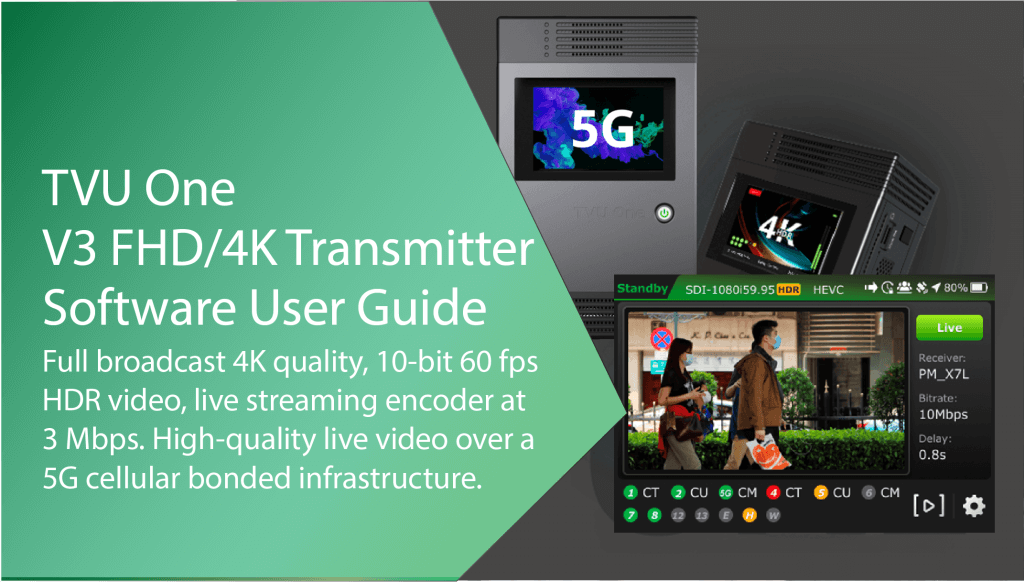
Chapter 1 – Introduction, setup, and base operation
TVU One represents a tremendous leap forward in professional live video streaming solutions. Choose from one of two TVU One transmitter models; the TVU One FHD and the TVU One 4K (also referred to as packs) in this document. The TVU One transmitter is 5G ready with UHD quality and sub-second latency.
Product overview
TVU One 4K delivers high-definition picture quality with 0.5-second latency at 3 Mbps within an ultra-compact, rugged hardware design. The TVU One FHD and 4K transmitters use the H.265/HEVC or H.264 encoding and compression standard to deliver greater efficiency in data use and increased transmission stability.
The H.265 hardware encoding chip delivers full broadcast quality in 4K, 10-bit true 60 fps video at as low as 3 Mbps with proven patented Inverse StatMux Plus technology, (IS+). IS+ is the ultimate transmission algorithm. TVU One 4K uses less data and combats packet loss to achieve transmissions with virtually zero latency, down to 0.5 seconds, even in a moving vehicle or when going live in 4K. The TVU One FHD transmitter can also transmit live 1080p-60 at as low as 800 Kbps.
Both TVU One transmitter models simultaneously aggregate up to 12 data connections and can obtain bandwidth from anywhere: cellular 3G/4G/5G LTE, WiFi, Ethernet, or satellite.
The TVU One 4K and FHD models have 100% more battery life than their predecessors. The TVU One FHD can communicate using IFB and bidirectional VoIP between the studio and the field operator without latency.
Real-time dual encoding makes it possible to go live under any network conditions by simultaneously recording a full HD copy of your video for later download.
Features, contents, and functions overview
Transmitter enhancements and new features:
TVU One model 4K
- Rugged chassis CNCed from high-density aluminum Portable with one-button operation.
- The first and smallest 5G ready, 4K p60 live transmission device compatible with more devices and video formats than ever before.
- Reliable, low-latency, high-quality transmission. True 60 frames per second (full motion).
- Support for up to 12 data connections; 6 embedded nano (4ff) modems (2 for 5G), 4 external USB, WiFi, and Ethernet. Supports LTE Category 12 global modems.
- USB WiFi adapter support.
- Supports VLAN mode, which connects to a receiver’s VLAN without having a router data plan. Supports VLAN and Switch support.
- Type 10 Micro SD support for up to 8 hours of high-quality video storage. The Pack ships with a 128 GB SD card.
- On-board SDI and HDMI input.
- Encodes at 4K 60p and 1080p.
- HEVC/H.265 or H.264 video compression.
- Lower power consumption internal battery supports up to 4.5 hours of live 4K transmission.
- Auto Sync support via USB drive.
- Audio-only transmission mode support.
- TVU Pack Low bitrate user notification via twitch command and pack UI.
- IPv6 support.
- New version alert on LCD screen with user triggered software update.
- RVF adapter status and version display (v6.8.2 and v7.0) Supports RVF control via touch screen. Includes an RVF option to support viewing return video feed from an iPhone or iPad.
- GPS and Partyline status display. Support for access to TVU Partyline as a participant (unavailable in 4K format).
TVU One model FHD
- Rugged chassis CNCed from high-density aluminum. Portable with one-button operation.
- The first and smallest 5G ready, live transmission device compatible with more devices and video formats than ever before.
- HD 1080p-60 encoding at as little as 800 Kbps.
- Type 10 Micro SD support for up to 8 hours of high-quality video storage. The Pack ships with a 128 GB SD card.
- On-board SDI and HDMI support. Supports dual input switching (SDI/HDMI)
- HEVC/H.265 or H.264 video compression.
- Support for up to 12 data connections; 6 embedded nano (4ff) modems, 4 external USB, WiFi, and Ethernet. Supports LTE Category 12 global modems.
- USB WiFi adapter support.
- Supports VLAN mode, which connects to a receiver’s VLAN without having a router data plan. Supports VLAN and Switch support.
- Lower power consumption internal battery supports up to 4.5 hours of live transmission.
- Auto Sync support via USB drive.
- Audio-only transmission mode support.
- TVU Pack low bitrate user notification via twitch command and pack UI.
- IPv6 support.
- New version alert on LCD screen with user triggered software update.
- RVF adapter status and version display (v6.8.2 and v7.0).Supports RVF control via touch screen. Includes an RVF option to support viewing return video feed from an iPhone or iPad.
- GPS and Partyline status display. Supports access Partyline (RTIL+ISSP+Timelock).
- Supports access to TVU Partyline as a participant (unavailable for 4K format).
Features and functions
TVU One transmitter models have a robust hardware design and functions to fit the needs of any live broadcaster. The TVU One runs on the TVU platform and includes the following features and functions:
- Simple Worry-Free Operation: TVU pioneered a one-button operation in portable live video streaming transmitters. TVU One requires no in-field configuration and boots up in less than 30 seconds.
- Small Form Factor, Big Features: TVU One is feature-rich with no compromises to performance or capabilities. To see a full list of hardware and software specifications for TVU One, refer to “Product Specifications.”
- Inverse StatMux Plus: TVU One features proprietary video transmission technology called Inverse StatMux Plus (IS+). With IS+, the unsurpassed HD picture quality is dependably delivered at sub-second latency over cellular 3G/4G/5G LTE modems, even when transmitting in a moving vehicle traveling at over 60 mph/100 kph.
- Powerful Real-Time Store and Forward: TVU One can simultaneously live stream and record. TVU has HD file transfer functionality that ensures the delivery of an HD quality error-free video clip to the studio in real-time without waiting until the clip is fully recorded on the transmitter.
- Digital memory card slot and video storage: Supports a 128 GB SD card (providing 8 hours of high-quality video).
- Fully Compatible with TVU Grid: TVU’s IP-based video switching, routing, and distribution solution allows a broadcaster to share a TVU One live video transmission with any other TVU Grid-enabled station, operations center, or physical location. TVU Grid features very low latency when switching, routing, or distributing live video.
- Integrates with TVU Command Center – This provides a cloud-based centralized management and control solution of all TVU devices and services.
- Support for return video feed HDMI adapter (optional): Use this device to receive a high-quality, low-latency SDI return feed in the field from a TVU receiver in the studio, where it can be monitored locally on an HDMI monitor.
- Improved audio quality: Optimized audio transmission quality and compatibility. Supports high bit-rate audio setting up to 320 Kbps.
- Support for external Bluetooth adapter (optional): Communicate via VoIP wirelessly with an external Bluetooth adapter.
- 5G Ready: Two internal hardware radios can be upgraded to 5G technology.
- Support for external 5G devices – Connect to certain external 5G phones/MiFi devices to enable hotspot usage.
- Closed caption pass-through: Support for embedded pass-through of closed captions for 1080i and 720p.
- Support for TVU Partyline: Integrates with remote video conferencing as a TVU One source.
- Speedtest feature: Supports speed testing of the transmission between the transmitter and receiver.
- USB file upload: Supports USB file uploads from a flash drive.
- Stream control: Supports streaming output of a receiver remotely.
About this guide
This software user guide provides detailed information about the following topics:
- Important safety guidelines
- Product overview and features
- Introduction, software setup, and configuration
- Advanced configuration
- Advanced operations
- New User Interface introduction, software setup, and configuration
- File-based workflows
- Product specifications
Chapter 2 – Introduction, software setup, and configuration
Before you begin
Before using this TVU One software user guide, refer to the latest TVU One hardware user guide. TVU One software builds (v6.8.2 and v7.0) support the RVF adapter. Build v7.0, and higher features two LCD console interfaces to choose from. From the About screen, build v7.0 and higher allows the option to upgrade to the improved User interface, which allows easy access to configuration settings.
If you prefer using the new TVU One User Interface, refer to “Chapter 5 – New User Interface Introduction, Software Setup, and Configuration.” Otherwise, continue with Chapter 2.
Note: To upgrade to the new software version, contact TVU Support at support@tvunetworks.com.
TVU transmitter LCD touchscreen interface
The transmitter’s LCD touchscreen interface allows transmission control while in the field. When the transmitter is first turned on, and SDI connected, the user will see the status display screen.
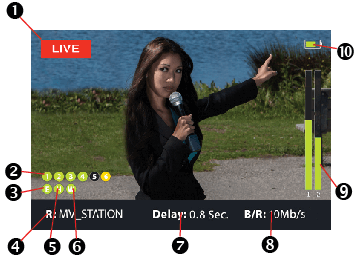
The TVU test pattern will display on the LCD screen if no transmission feed is connected.
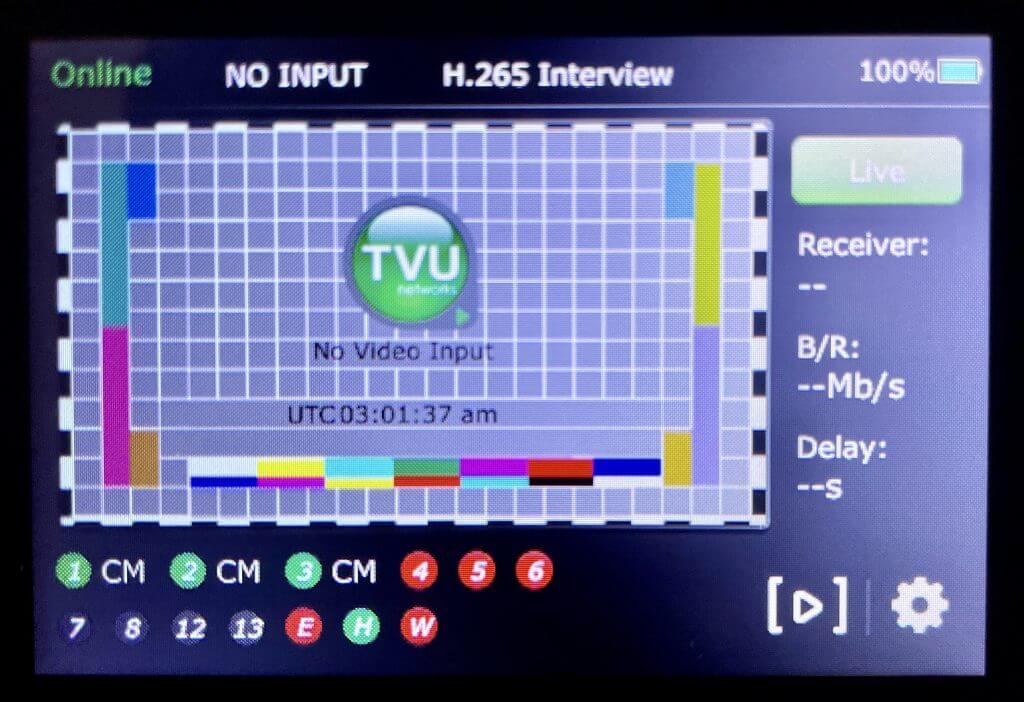
TVU One transmitter Live status screen descriptions
(1) Transmission Status: The transmission status monitor displays the current transmission status of the TVU Pack. If the LCD screen displays “LIVE,” it indicates the transmission is Live. If a camera or input source is not connected to the TVU One transmitter, the LCD panel will display “Online” (Standby) or Preview mode.
(2) Data Card Status Monitor:
Displays the current number and status of all data cards connected to the TVU One. The status of data cards connected to the Pack will appear as green, red, orange, or black. Green status indicates that the data card is connected. Orange status indicates that the data card is attempting to dial. The red status indicates that the data card is not connected. Black status indicates there is no card.
(3) Ethernet Connection: Displays the status of the Ethernet connection.
(4) Receiver Name: Shows the receiver name to which the unit is transmitting.
(5) Hotspot Connection: Displays the status of the hotspot connection.
(6) WiFi Connection: Displays the status of the WiFi connection.
(7) Latency Status: Displays the current latency of the transmission.
(8) Bit Rate Status: Displays the current Bit Rate (B/R).
(9) Audio Input Level Monitor: Dynamically displays the unit’s audio input level (DBFS) with graphical colors. Analog audio input is available via IFB port to embedded SDI.
The Audio mapping feature (e.g.) replace channels 1-2 with channels 3-4.
(10) Battery Status: Indicates the status of the battery.
Operating the TVU transmitter
The LCD screen on the transmitter can be operated with simple taps and swipes of a finger, much like a smartphone with a touchscreen user interface. When accessed, the operational functions and status display interfaces available will appear as a pop-up window or drop-down menu that overlays the preview or live video input. Follow these instructions to access all the transmitter’s features and functions through its LCD touchscreen.
Going Live without updating the console
To go Live, complete the following steps:
- Turn On the TVU transmitter.
- Connect the TVU transmitter to a camera source.
- Tap the center of the LCD screen. A pop-up screen displays.
- Select the receiver with which you would like to go Live with. Then, press the red Go Live button.
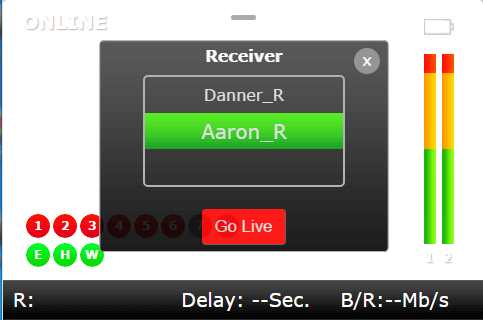
- When prompted, touch the LCD screen and slide the toggle to the right to start the Live transmission.
Note: To Exit from going Live, touch the X in the top right corner of the screen to close the window.
- To stop a Live transmission, tap the center of the LCD screen. A “Stop Live” option will be displayed on the screen’s bottom. Slide the toggle from left to right to stop the Live transmission.
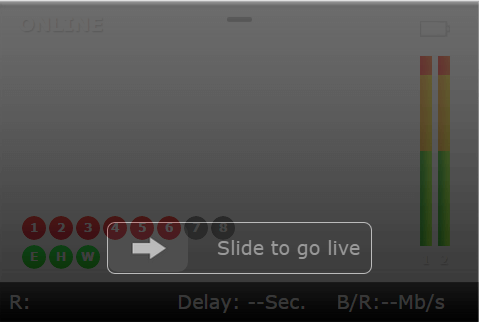
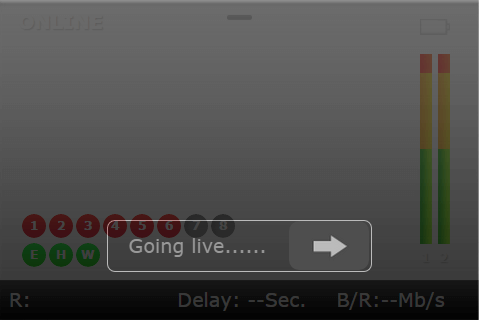
To stop a live transmission, tap the middle of the touch screen, and a pop-up screen will appear. A “Stop Live” toggle will appear at the bottom of the page. Slide the toggle from left to right to stop the live transmission. The LCD will display “Standby” in the upper left corner of the screen when the live transmission is stopped.
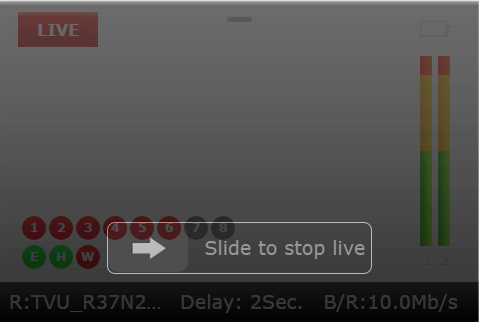
Selecting a preset transmission mode
To select a preset transmission mode, complete the following steps:
- Touch above the center of the LCD screen and slide your finger down. The Mode window displays.
- Slide to select one of the following options:
Note: Your selection will highlight green. The pack must be in live mode before you can change selections.
- Interview: Bitrate 2048, delay 2 seconds
- Normal: Bitrate 5120 delay 4 seconds
- Fast Moving: Bitrate 5120, delay 8 seconds
- SD: Bitrate 2048, delay 4 seconds
- Tapefeed: Bitrate 10240, delay 10 seconds. This mode is optimized for content with multiple scene changes.
- Custom: A custom transmission mode set by the receiver
- To save your selection, Click OK.
- To exit from the menu, click the X in the top right corner of the screen.
Latency management
To manage the second and sub-second Latency settings, complete the following steps:
- Touch the top of the LCD screen and slide your finger down.
- Touch above the LCD screen and swipe from right to left once. The Latency window displays.
- Scroll through the menu and tap the menu to make your selection. Then, press OK.
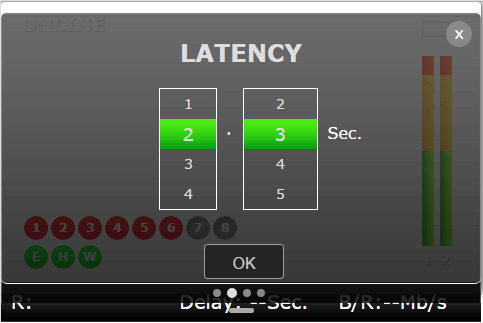
- To exit from the menu, click the X in the top right corner of the screen.
Data card monitoring
To monitor detailed transmitter information as well as Ethernet, hotspot, and WiFi connections, complete the following steps:
- Touch the center of the LCD screen and slide your finger down.
- Touch the LCD screen and swipe from the right to the left three times. The Slot monitoring window displays.
(1) Ethernet
(2) Hotspot
(3) WiFi connection
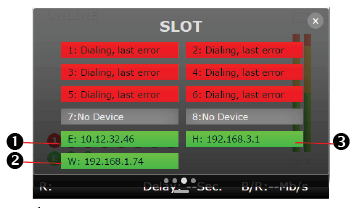
- To exit from the menu, click the X in the top right corner of the screen.
Selecting an encoder type
The TVU One model FHD and 4K support onboard H.265/HEVC or H.264 encoding.
To select an encoding option, complete the following steps:
- Touch the top of the LCD screen and slide your finger down.
- Touch above the LCD screen and swipe from left to right until the Encoder Type window displays.
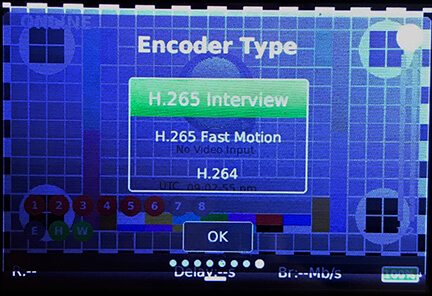
- Touch and slide the menu to make your selection. Then, press OK.
- To exit from the menu, click the X in the top right corner of the screen.
Turning Off the TVU One transmitter
To turn off the TVU One transmitter, complete the following steps:
- Press the power button once. A sliding button will display on the LCD screen.
- Slide the button from left to right to power down the unit.
Charging the internal battery
Note: The battery will charge faster if the TVU One unit is powered OFF.
The TVU One comes with an AC adapter to charge the unit. To charge the TVU One, connect the AC adapter as shown.
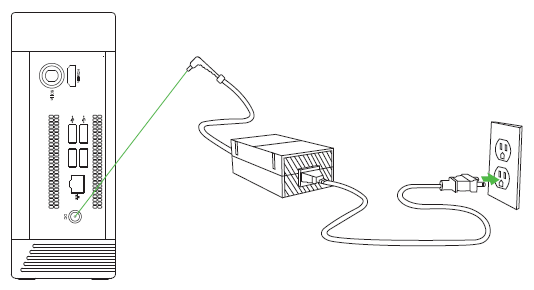
Power button status when charging
The TVU One TM1000v3 displays the following power button status when the AC adapter is properly connected and the battery is charging:
- The unit is powered on when charging: Displays a steady green light.
- A flashing red and green light is displayed during a forced shutdown while power is on.
- The unit is powered off and charging: Displays a flashing red light.
- When fully charged, the power off displays a steady red light.
- The power light is off when the battery is not charged or connected to the unit.
Chapter 3 – Advanced configuration
TVU One transmitter information
To access the TVU One model number, Peer ID, software version, App version input, format, and transmitter configuration information, complete the following steps:
- Touch the top of the LCD screen and slide your finger down.
- The transmitter information window displays.

- To exit from the menu, click the X in the top right corner of the screen.
TVU One status monitoring and control using a Web browser, iPhone, or smart mobile device
The TVU Transmitter’s operational status can be monitored, and various transmission functions can be controlled from a Web browser. This interface can be accessed using a standard web browser connected to the TVU One hotspot USB port on the side transmitter panel.
Connecting the TVU One to the internal hotspot
Complete the steps in the following procedure to configure the TVU One to the internal hotspot using your iPhone or smart mobile device.
Configuring the TVU One transmitter for hotspot (optional)
- Search for the hotspot on your iPhone/smart device. Then, when prompted, enter the case-sensitive SSID:
TVUPACK_XXXX
(Where X is the last 4 digits of the transmitter’s PID)
The default password is the last 8 digits of the TVU One PID
Note: All password characters are uppercase. The password can be changed in the Web UI if desired.
- Connect to the SSID using your iPhone/smart device. Refer to the following examples of how the status screens display on a smart device Web browser.
- Once the connection is established, you can open a web browser and enter http://192.168.4.1 in the address line to see the pack status.
- Click the Home tab to view the system information.
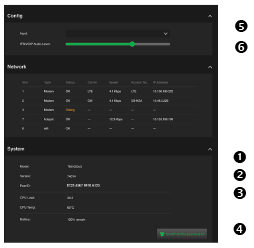
The TVU One FHD and 4K models include a digital audio input with embedded SDI that supports up to 8 channels. This feature provides an optimized audio transmission quality and compatibility and supports high bit-rate audio up to 320 Kbps. Analog audio input is possible via IFB port to embedded SDI.
The audio-only option is only available after enabling the feature.
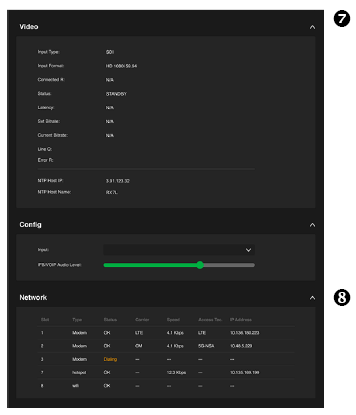
TVU One transmitter functions and status screen descriptions are as follows:
(1) Drop-down menu: Use the drop-down menu to select, monitor, and control all aspects of transmission, including data cards, Ethernet, WiFi, BGAN, Receiver, and return video feed.
(2) TVU Pack information: This provides information about a specific TVU Pack, including its model number, version number, and PID.
(3) CPU: Displays the current CPU capacity and temperature.
(4) Battery: Main battery status.
(5) Input: Displays the input source.
(6) IFB: This function allows the user to change the audio level of the IFB function. It also includes analog audio input via the IFB port to embedded SDI.
(7) Video: Displays video transmission information and status.
(8) Network: Modem card information, including type, connectivity, and IP address, all organized by slot number.
Ethernet configuration
Complete the following steps in this procedure to set up and configure Ethernet using the TVU One setup and configuration window.
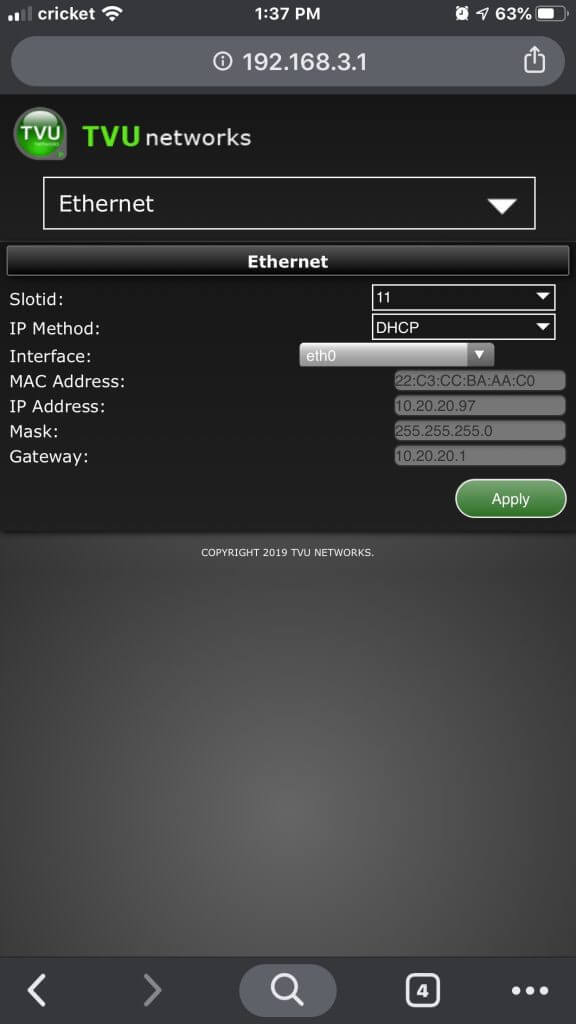
- Click the drop-down menu and select Ethernet.
- Click the Slot id drop-down menu and select a slot number.
- Click the IP Method drop-down menu and select a Static IP or DHCP IP method.
- If your IP method is static, you can enter a static IP address in the IP Address field.
- If your IP method is static, enter the Subnet Mask in the Mask field.
The DHCP IP address is automatically generated and cannot be manually entered.
- If your IP method is static, you must enter the Gateway in the Gateway field.
- Press the Apply button to save your changes.
WiFi configuration and settings
The WiFi menu provides configuration information and access to change the WiFi settings. The transmitter can optionally support multiple WiFi connections by purchasing optional hardware. For more information, contact TVU Networks support.
When multiple WiFi adapters are connected, you can scan available slots for WiFi adapters and configure the WiFi login information using the TVU One WiFi setup and configuration window.
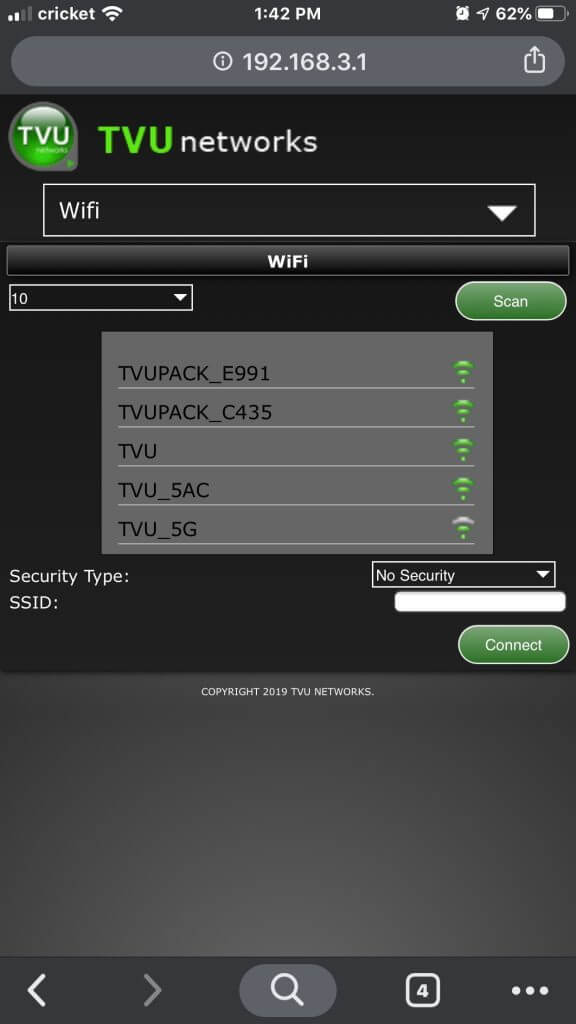
Configuring WiFi
Complete the steps in the following procedure to configure your WiFi settings:
- Click the drop-down menu and select WiFi.
- Press the Scan button to display any available networks. Available networks display in the center panel. Choose the desired network from the center panel.
- Click the Security Type drop-down menu to review the connection’s security type. This setting supports WPA-DSK and WEP.
- In the SSID field, verify your wireless network name.
- Click Connect to save your changes.
TVU One hotspot settings
The hotspot menu provides status information on clients connected through the hotspot.
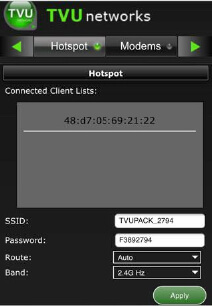
Configuring hotspot
Complete the following steps in the following procedure to view and change hotspot status:
- Click the drop-down menu and select Hotspot.
Note: The Connected Client list window displays a list of devices that are connected by way of hotspots.
- To update the Password, edit the password field provided.
Note: The new password must be 8 characters and does not take affect until the system is restarted.
- The hotspot feature will enable a connected device to access the internet through one of the available network connections. This access allows file transfers via FTP or any other internet access. If higher bandwidth is required, refer to the topic “Router setting.”
- To manually select the route taken (for example, a Hotel WiFi network), choose the path from the Route drop-down menu.
- In the Band drop-down menu, choose 2.4 GHz or 5 GHz.
- Click Apply to save your changes.
Modem configuration
The Modem screen provides modem configuration information. Many cellular data cards are automatically detected by the TVU transmitter and will self-configure. If this is the case, no further action will be required. If a data card needs configuring, you can use the Modem menu to configure specific data cards.
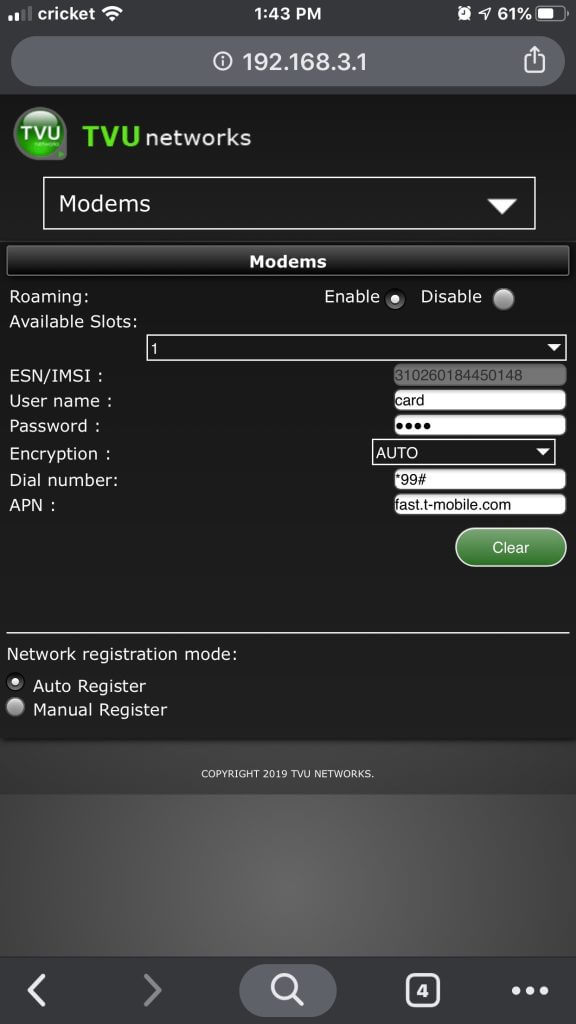
Configuring data cards
Complete the steps in the following procedure to configure specific data cards:
- Click the drop-down menu and select Modems.
- Click the Available Slots drop-down list to display a list of available slots for configuration.
- Go to the User Name field and enter the carrier user name information from the network carrier.
- Go to the Password field and enter the carrier password information from the network carrier.
- Click the Encryption drop-down menu and select the appropriate encryption standard.
- Go to the Dial number field and enter the carrier dial information from the network carrier.
- Go to the APN field and enter APN information from the network carrier.
- Under the Network registration mode, select the Manual register radio button when roaming.
- Click the Scan Carrier button to scan for available carrier networks.
- Click Apply to save any changes.
Chapter 4 – Advanced operations
Receiver status and control
Advanced control of the receiver’ Live session can be configured by using the Config page available through the TVU One hotspot feature.
Use the Config window to control bit rate and delay by entering your data in the respective fields and clicking the Apply button to save your settings. This status window also allows you to choose the operational mode provided in the drop-down menu at the bottom of the screen: Interview, Normal, Fast Moving, SD, Tape Feed, and User Definable.
Controlling the live transmission
Complete the steps in the following procedure to select an alternate receiver, view its status, and set up and control a ”Live” transmission:
- Click the drop-down menu and select Receiver.
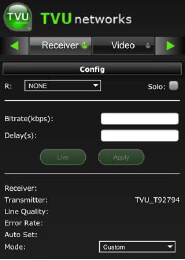
- The R: drop-down menu displays the receiver’s name. To view and select a different receiver, click the R: drop-down menu to scroll and select a receiver from the list.
- Click the Solo check box if you want a particular TVUPack to only display ‘Online” on the receiver you selected from the R: drop-down menu.
- In the bitrate (kbps) field, enter the desired transmission bit rate and delay(s).
- Click the Apply button to save your changes.
- To Start or Stop the live transmission, click the Live button.
Note: Below the Live and Apply buttons you can view the Receiver status. Receiver status displays the current TVU Pack Receiver ID, TVU Pack Transmitter ID, Line Quality, Error Rate, and Auto Set information.
- Click the Mode: drop-down menu to select an alternate Mode for optimized preset bit rate and latency based on the broadcast setting(s).
Chapter 5 – New User Interface introduction, software setup, and configuration
Updating the console and Going live
- Press the power button, and the TVU One transmitter will begin to boot up.
- Navigate to the About screen. Swipe your finger from top to bottom once on the LCD touchscreen. Then, swipe left to right until you reach the About screen.
- Tap the Switch to the new console button at the bottom of the About screen. Then, follow the prompt to reboot.
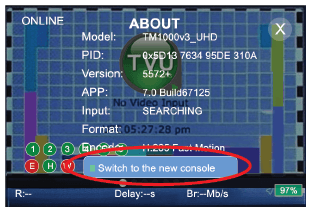
- Follow the prompt to reboot.
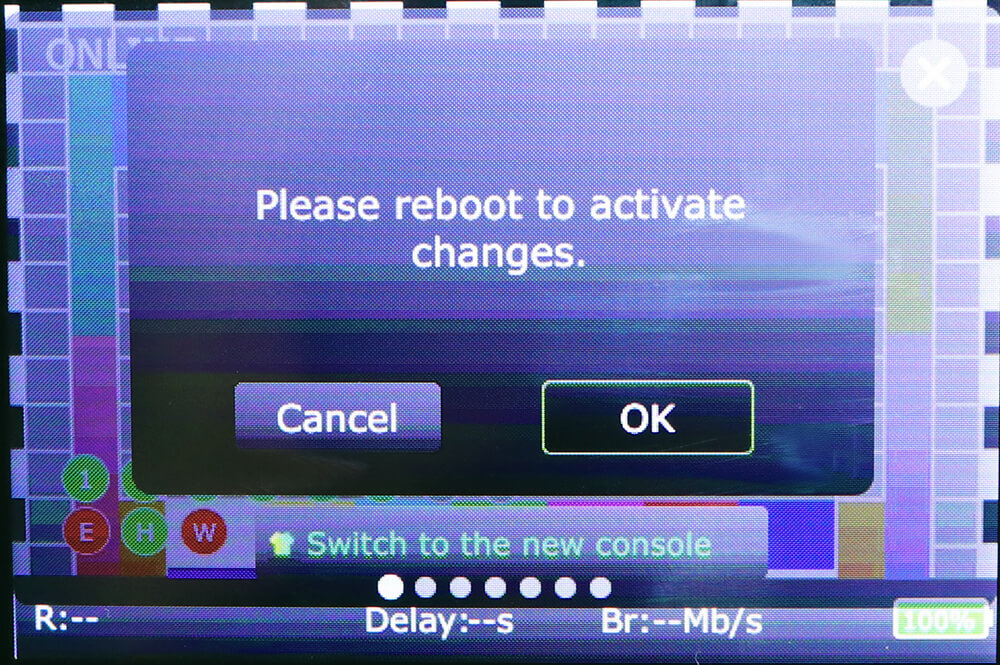
After reboot, the initial status screen displays.
- After the unit reboots, the modems begin to connect automatically.
Note: Modem removal must be completed by TVU Support or an authorized TVU reseller.
TVU new LCD touchscreen interface
The transmitter’s new LCD touchscreen interface allows transmission control in the field. When the transmitter is first turned on and SDI connected, the user sees the status display screen.
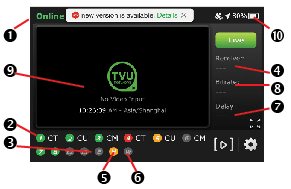
TVU One transmitter Live status screen descriptions
(1) Transmission Status: The transmission status monitor displays the current transmission status of the TVU Pack. If the LCD screen displays “LIVE,” it indicates the transmission is Live. If a camera or input source is not connected to the TVU One transmitter, the LCD screen will display “Online” (Standby) or Preview mode.
(2) Data Card Status Monitor:
Displays the current number and status of all data cards connected to the TVU One. The status of data cards connected to the Pack will appear as green, red, orange, or black. Green status indicates that the data card is connected. Orange status indicates that the data card is attempting to dial. Red status indicates that the data card is not connected. Black status indicates there is no card.
(3) Ethernet Connection: Displays the status of the Ethernet connection.
(4) Receiver Name: Shows the receiver name to which the unit is transmitting.
(5) Hotspot Connection: Displays the status of the hotspot connection.
(6) WiFi Connection: Displays the status of the WiFi connection.
(7) Latency Status: Displays the current latency of the transmission.
(8) Bit Rate Status: Displays the current Bit Rate (B/R).
(9) Display LCD: “No Video Input” displays on the LCD screen when the transmitter is not connected to a transmission feed.
(10) Battery Status: Indicates the status of the battery.
Updating the App
o view and upgrade to the new version, the device must have the “UserUpgrade” feature enabled. When enabled, a notification displays “New version available” on the LCD screen and configuration page.
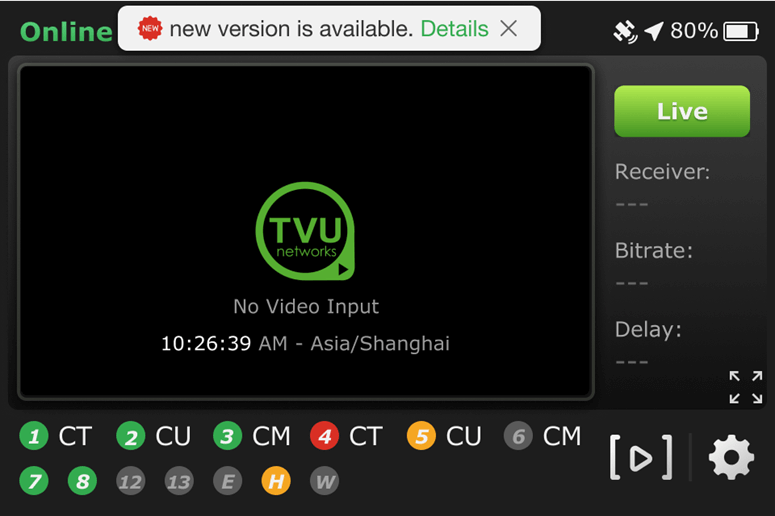
Updating the APP from the Configuration page
The user can also see the notification of the new version at the top of the Configuration page when there is a new APP version available on any page. Access the configuration page by entering “192.168.4.1” in the browser address bar.
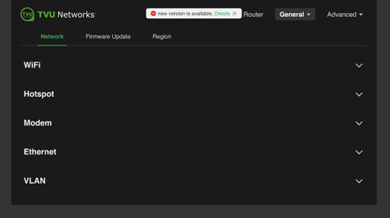
Click Details for more info about this new release, then click Update on this page to update the app version. Users can also choose to click Ignore this version or close the notification.
Note: If user’s choose to ignore this version, , they won’t be reminded of this version again unless a new one is available, regardless of whether their device is on or off.

If users want to know if there is an available app version, they can go to the “General Settings > App Updates” page, which will detect in real-time whether there is an available new version. A pop-up confirmation box for upgrading to the new version will appear above (as shown in the New version notification figure) if there is a new version.
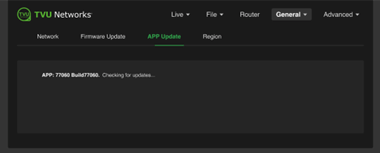
Updating the APP from the LCD Screen
When a new APP version is available, users can see the notification of the new version on the touch screen of their device.
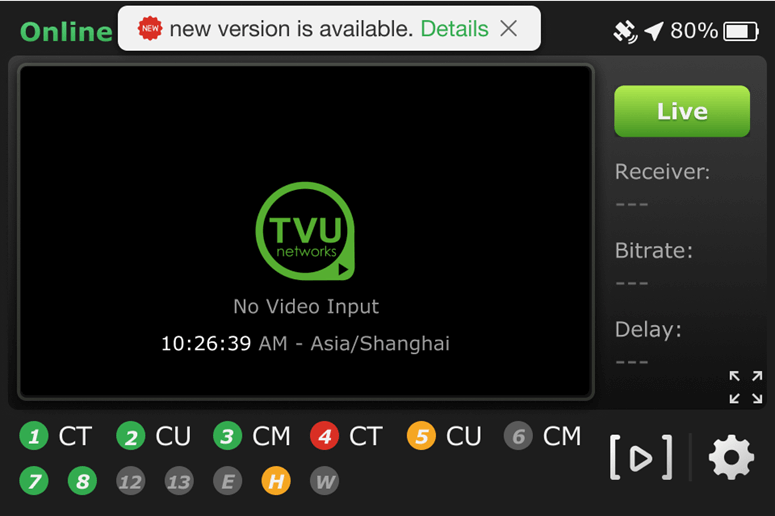
Click Details for more info about this new release, then click Update on this page to update the app version. Users can also choose to click Ignore this version or close the notification.
Note: If user’s choose to ignore this version, , they won’t be reminded of this version again unless a new one is available, regardless of whether their device is on or off.
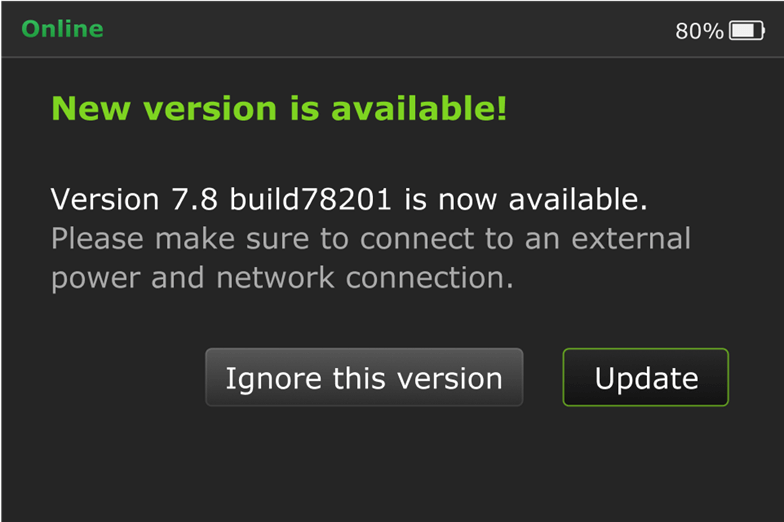
If users want to know if there is an available app version, they can go to the Config Settings > About page to check. If there is a “New” icon after the APP version on the About page, to indicate that there is a new version available. Clicking on the New icon will allow you to view detailed version information, as shown in the “New version is available notification – LCD screen” figure.
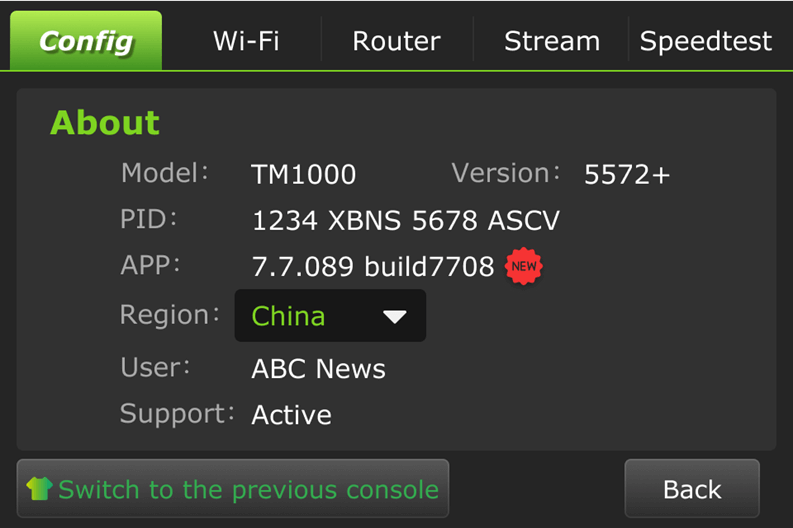
Going live
There are two methods to take your transmission live:
- Tap the Live button on the initial status screen. This will default to the receiver with which you recently went live.
- Tap the Settings gear icon and select a receiver from the Config tab. See “Selecting a receiver and going Live.”
- Tap the Live button on the initial status screen to start the live transmission.

- The TVU One unit will prompt you to slide the ‘Slide to go live’ button from left to right.
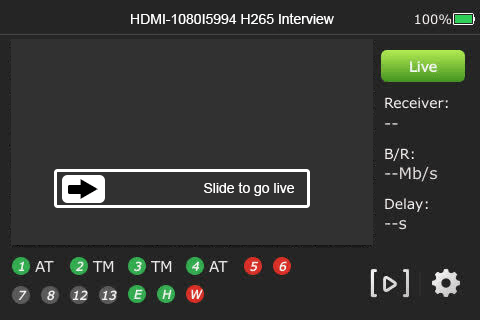
- Once the button is engaged, the TVU One begins the live transmission using the last receiver with which you most recently went Live.
Selecting a receiver and going Live
All configuration options and settings are now accessible using the gear-shaped Settings icon in the LCD’s bottom left.
- Tap the gear icon to open the Settings screen.

- Tap the Config tab and tap Receiver.
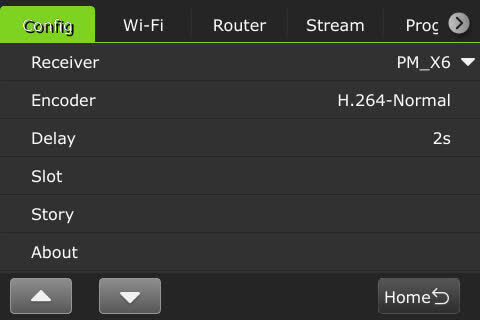
Note: All of the selections in the Config tab are clickable except for the Story selection.
- Select the desired receiver from the drop-down menu with which you want to go live and tap the Go Live button.
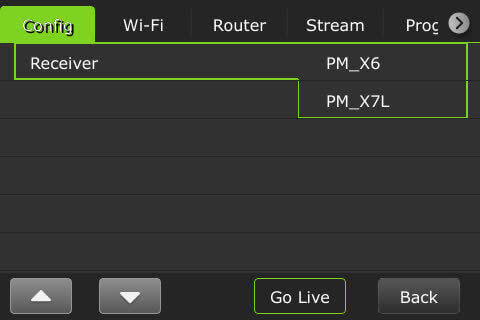
Note: When starting a live transmission from this menu, you will not be prompted to slide a button. The transmission will begin with a countdown.
- If you only want to select a receiver but do not want to go live, tap the Back button at the bottom right corner of the LCD touchscreen.
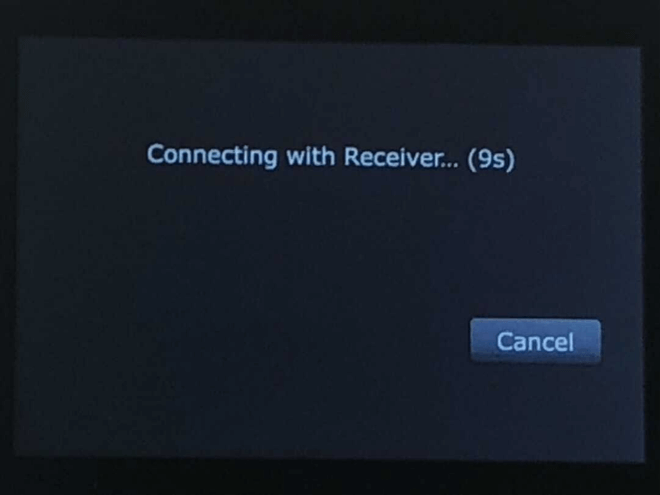
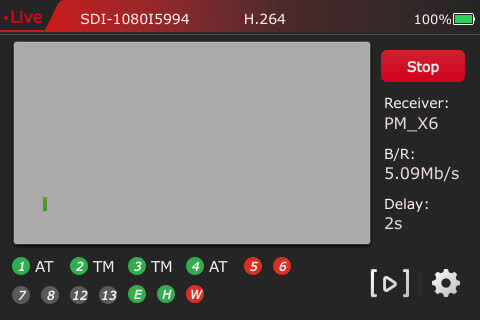
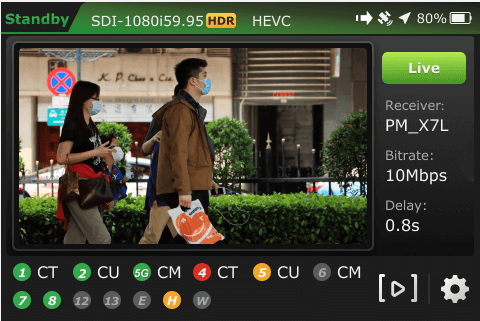
Selecting an encoder option
The TVU One model FHD and 4K support onboard H.265/HEVC or H.264 encoding.
To select an encoding option, complete the following steps:
- Tap the Gear to open the settings window and the Config tab.

- Tap Encoder.
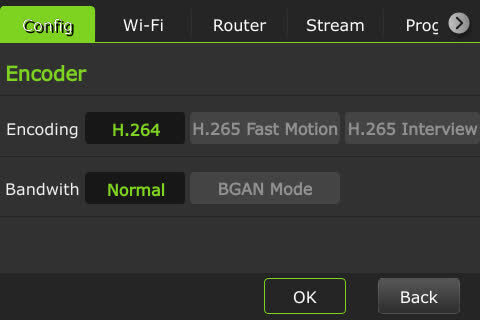
- Slide and tap to select one of the following options:
Note: Your selection will highlight green. The pack must be in live mode before you can change selections.
- H.265 Interview: Bitrate 2048, delay 2 seconds
- H.264 Normal: Bitrate 5120 delay 4 seconds
- H.265 Fast Motion: Bitrate 5120, delay 8 seconds
- Bandwidth: Normal or BGAN mode
- To save your selection, Click OK.
- To exit from the menu, click the Back button.
Delay management
To manage the second and sub-second Latency settings, complete the following steps:
- Tap the Gear icon at the bottom of the LCD.
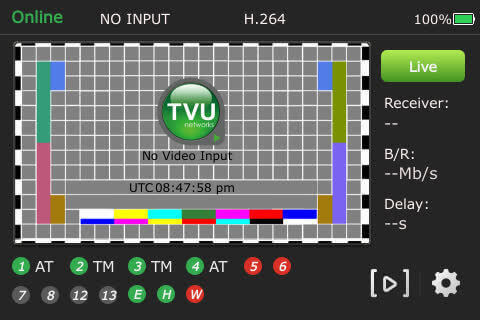
- The Config tab displays. Tap Delay.
Note: To exit this menu, tap the Home button.

- Scroll through the menu using the up and down arrows to change the settings and press OK.
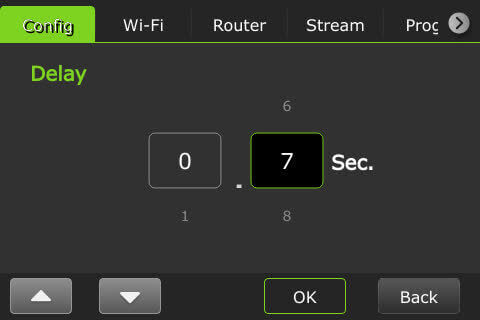
- To exit from the menu, tap the Back button.
TVU Pack user Bitrate Warning notification via Twitch command and pack UI
Access the device’s configuration page by entering “192.168.4.1” in the browser address bar. After entering the configuration page, there is a Low Bitrate Warning switch on the receiver page under the “Live” menu, with the default state set to off.
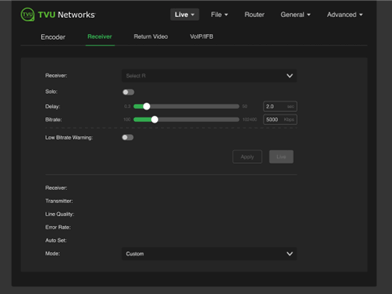
When users enable the “Low Bitrate Warning,” the “Low Bitrate Threshold’’ will follow the transmission bitrate setting by default so that users can always know if the transmission bitrate is lower than their set bitrate.
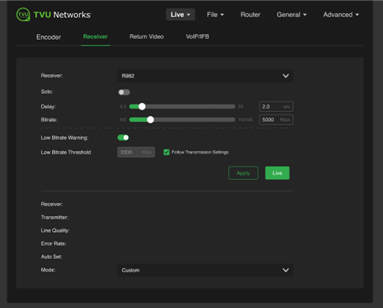
Users can also manually uncheck the “Follow Transmission Settings” checkbox, allowing them to set a limit threshold according to their own needs.
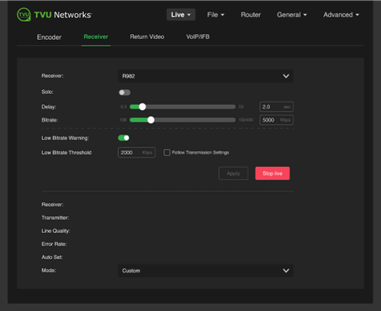
Users can see the warning message at the top of any page when the transmission bitrate is below the threshold. The message will remain visible until the user manually dismisses it or the Bitrate recovers above the threshold. If the user dismisses it manually, the system will perform another check after 30 seconds.
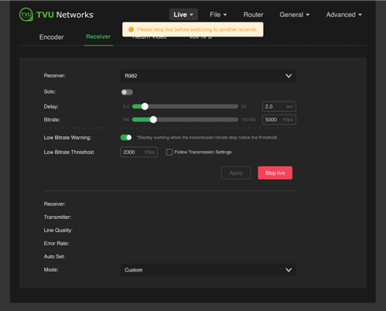
On the Pack LCD screen, users will see the top bar’s background color change to orange, and a warning notification, along with the highlighted threshold value, will be displayed. This message will remain visible until the user manually closes it or the bitrate recovers above the threshold.
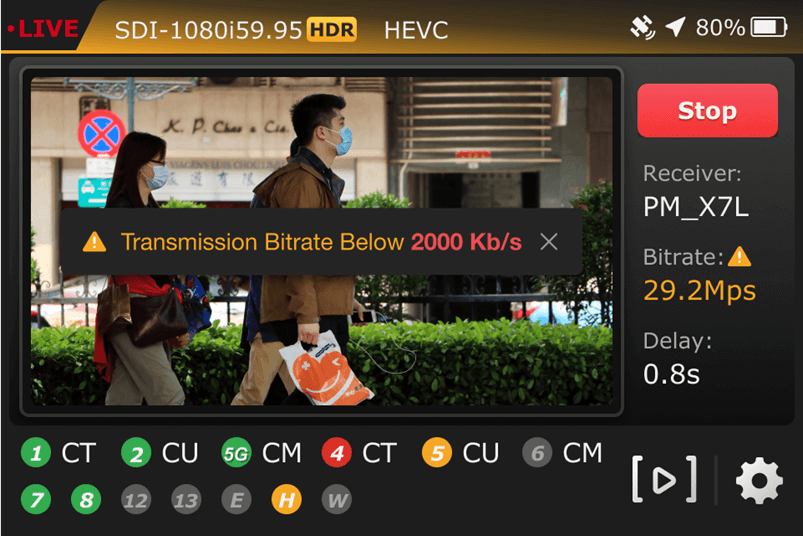
Data card monitoring
To monitor detailed transmitter information as well as Ethernet, hotspot, and WiFi connections, complete the following steps:
- Tap the center of the LCD screen. The status screen displays. Tap the Gear icon to display the Config tab.
- Tap Slot in the Config tab menu to display the Slot monitoring window. The data cards and their status display along with Ethernet, Hotspot, and WiFi indicators:
(1) Ethernet (2) Hotspot (3) Wi-Fi connection
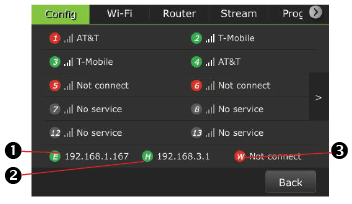
- To exit from the menu, click the Back button.
About page in the Config tab
The About page in the Config tab displays the Pack’s model number, Peer ID, software version, App version input, format, and transmitter configuration information.
To access the About screen, complete the following steps:
- Tap the Gear icon at the bottom of the LCD to open the Settings page.
- The Config tab displays. Tap About.
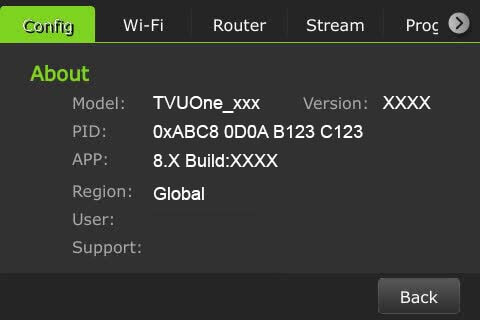
Note: You must reboot the Pack after changing the Receiver. Changing the Receiver during a live transmission may cause the live transmission to fail.
- If a live transmission fails after reboot, the following message displays if the wrong Receiver is selected. Choose the correct Receiver setting and restart your transmission.
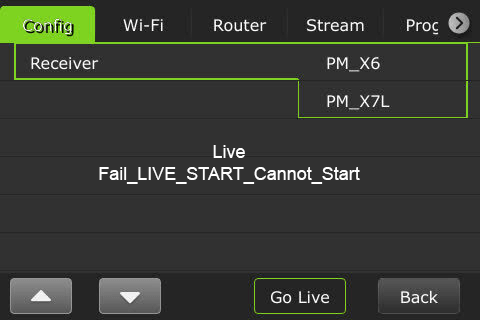
Language selection in the Config tab
The Config tab allows the user to choose English and Chinese languages. To select a language, complete the following steps:
- Tap the Config tab and use the down arrow to locate and tap the Language option. The default is English.

- Select your desired option.
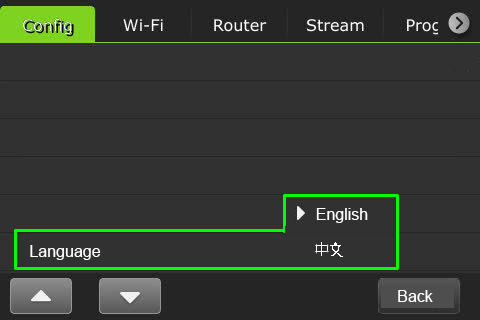
- When finished, tap the Back button.
Slot selection in the Config tab
A user can view the speed of each slot in real time from the Slot selection in the Config tab. To view a slot speed, complete the following steps:
- Tap the Config tab and tap Slot. The active slots display.
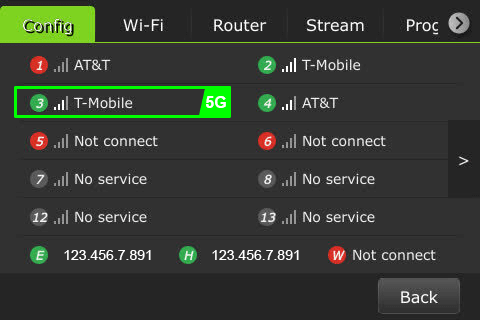
- Select a desired slot to view its real-time speed.
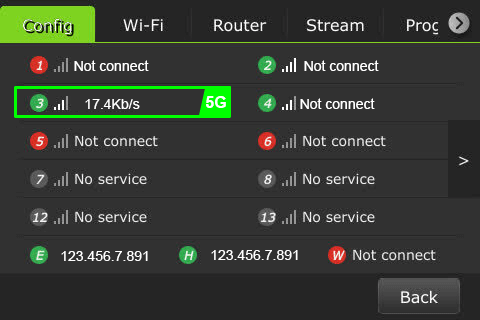
- When finished, tap the Back button.
Stream tab
Using the Stream tab, a user can control the stream output destination of a receiver remotely.
- Tap the Stream tab.
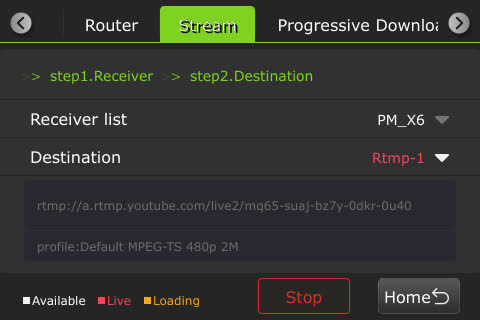
- Select a receiver from the “Upload to” drop-down list. Then, select a destination from the “From” drop-down list and tap Publish.
Progressive Download tab – Enable the feature
To enable the Progressive Download feature, complete the following steps:
- Tap the gear icon.
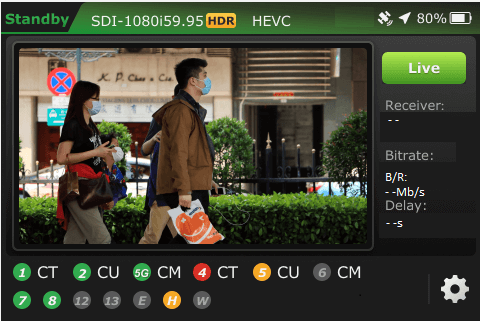
- The Pack menu displays. Tap the Progressive Download tab.
- To enable the Progressive Download feature, tap the Enable slider to the right until it turns green.
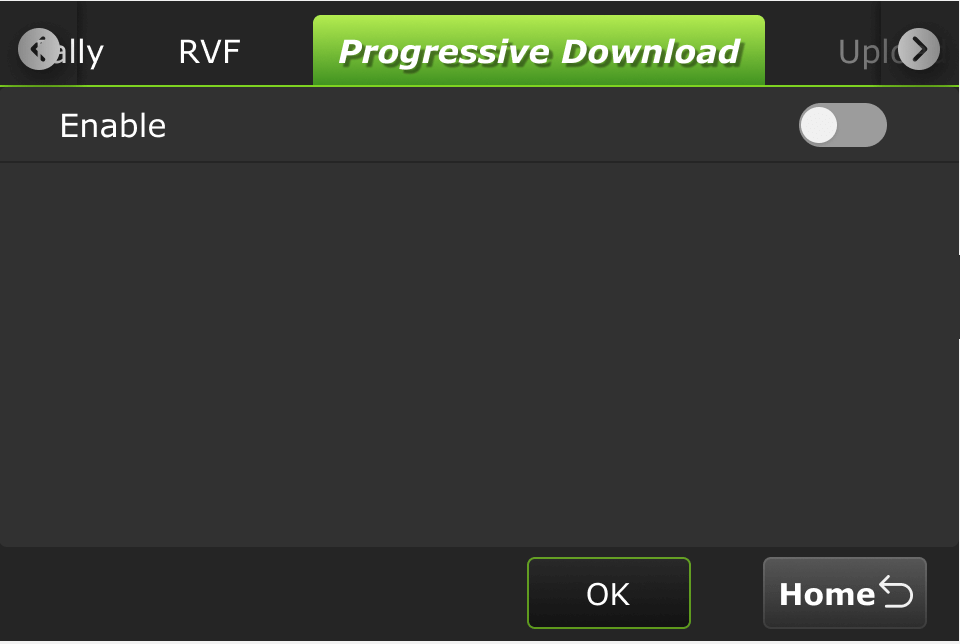
Your control selections display:
- The Camcorder default option displays and is controlled by the camera’s record button.
- Tap the Record button on the camcorder to display controls.
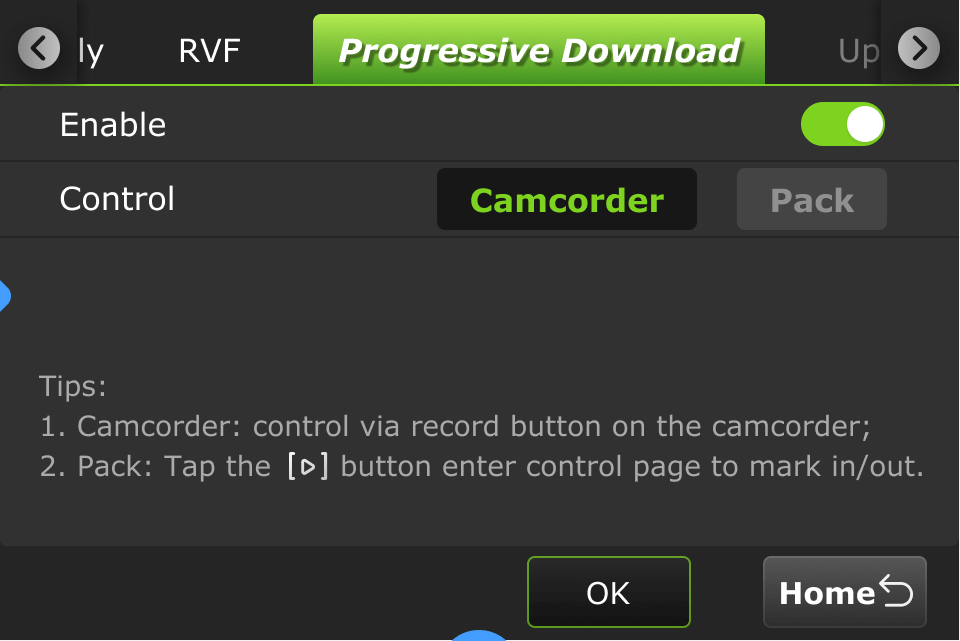
Note: Stop recording on the camcorder if you need to change your settings.
If you change the settings to the Pack during camcorder mode while it’s running, the following message displays.
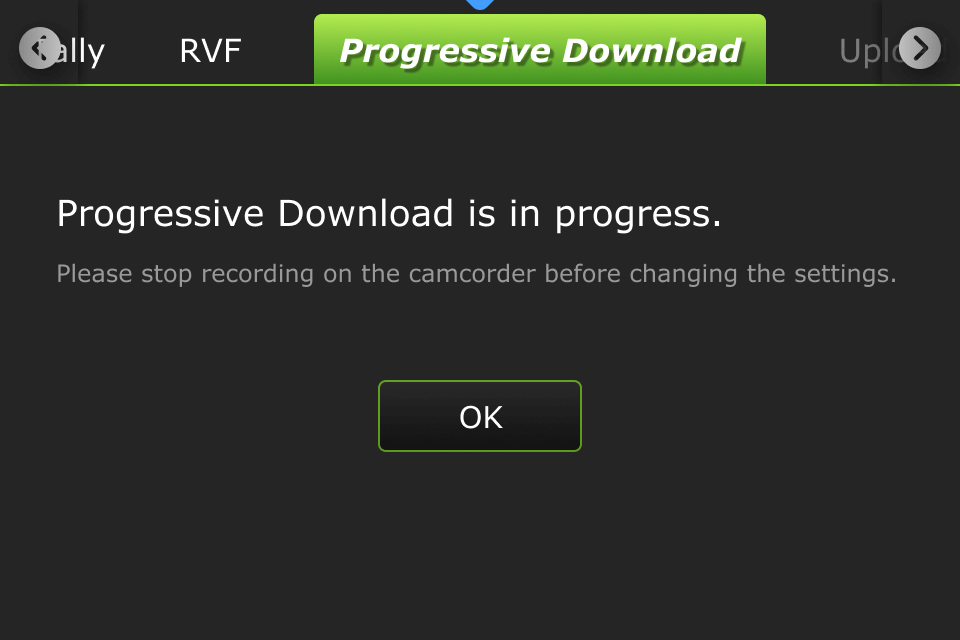
Camcorder mode
Camcorder mode can only be used with an SDI input. Having the time code inside the SDI signal is requested.
The following message displays if you change to camcorder mode when the pack mode is running, and the in point is set, but the out point is not set, the processing is interrupted, then it would use the current point as the out point.
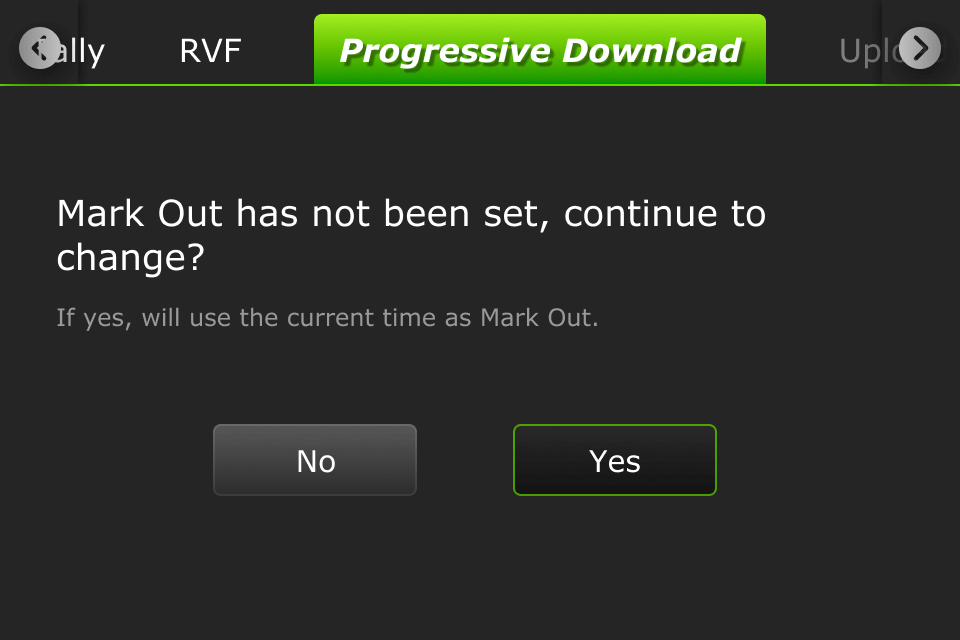
When in camcorder mode, when the camera is not recording, Standby “Stby” displays.
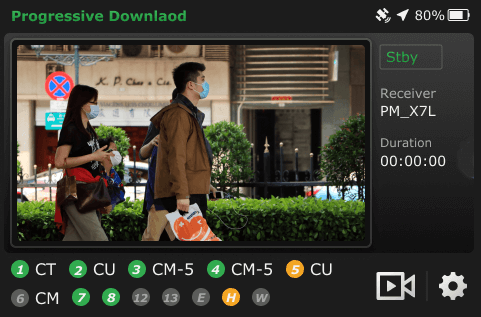
When the camcorder is recording, “Rec” displays.
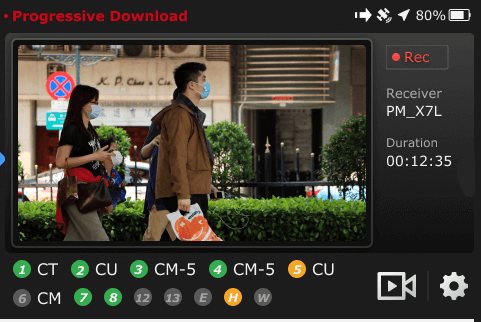
When the camcorder is finished recording, “Standby” displays.
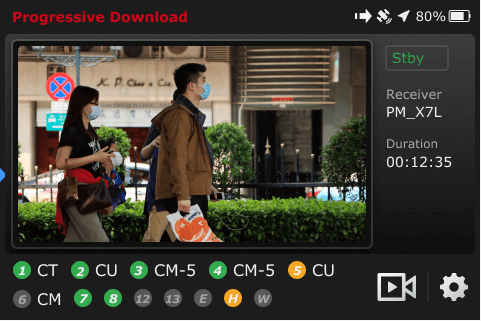
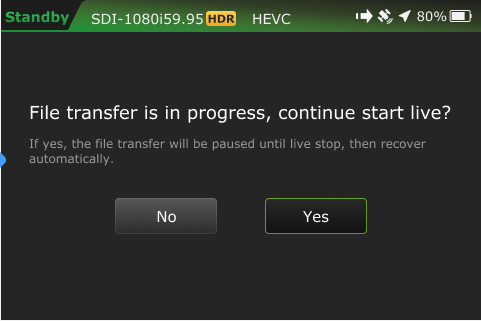
TVU Pack control mode
Pack mode can be used in either SDI or HDMI. Time code is not requested.
- You can control the clip on the TVU Pack by tapping the Pack button. Tap OK, and a Success prompt displays.
- Tap the Home button. Your feed will display in “Standby” mode.
- Tap the
 icon to enter the control page to set your mark in/out preferences.
icon to enter the control page to set your mark in/out preferences.

When a file is being transferred, including Progressive Download, download, and Auto Sync, a new file transfer ![]() icon displays in the top status bar. A prompt will display if a file is being transferred when the Pack is shutting down. The transfer
icon displays in the top status bar. A prompt will display if a file is being transferred when the Pack is shutting down. The transfer ![]() icon displays when a file is being transferred. Tap the file transfer
icon displays when a file is being transferred. Tap the file transfer ![]() icon in the status bar to enter the File Transfer page to view the details. This is only supported on the new console.
icon in the status bar to enter the File Transfer page to view the details. This is only supported on the new console.
- The
 icon is red when a Progressive Download is in progress.
icon is red when a Progressive Download is in progress. - The camera
 icon is red when the Pack is live with a receiver.
icon is red when the Pack is live with a receiver.
Transferring and marking the file
To access the Progressive Download feature, complete the following steps:
- From the Progressive Download display, tap the Mark in button to mark the in point. The transfer will start automatically.
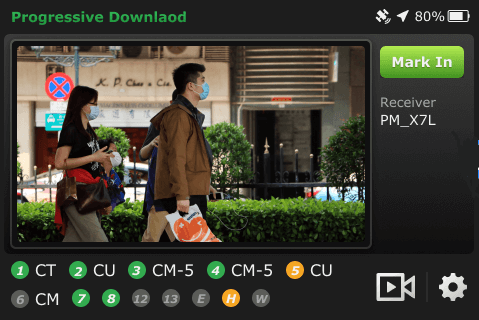
- When the file transfer begins, the transfer
 icon displays in the status bar. The file duration displays below the Mark out button.
icon displays in the status bar. The file duration displays below the Mark out button. - You can tap the file transfer
 icon in the status bar to enter the File Transfer page to view the details. This is only supported on the new console.
icon in the status bar to enter the File Transfer page to view the details. This is only supported on the new console. - Tap the Mark Out button to mark the out point.
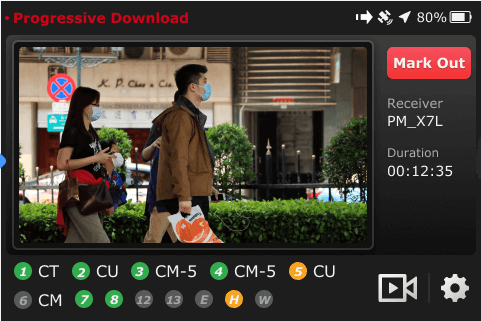
- The processing progress of the current clip displays.
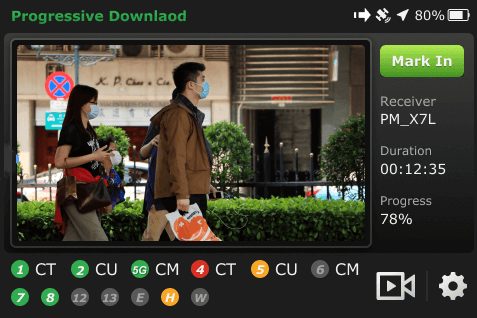
- When the file transfer Progress displays 100%, continue to “Taking the clip live.”
Taking the clip live
- After the file transfer is complete, this function can also be used during live streaming. To enter the live streaming interface, tap the
 icon.
icon.
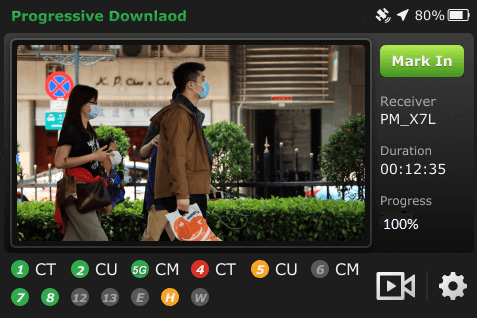
- The live streaming interface displays. To take your clip live, tap the Live button.

- Swipe the Slide to go live button to connect with the receiver. The Live streaming interface displays.

- To switch to the Mark interface again, tap the
 icon.
icon.
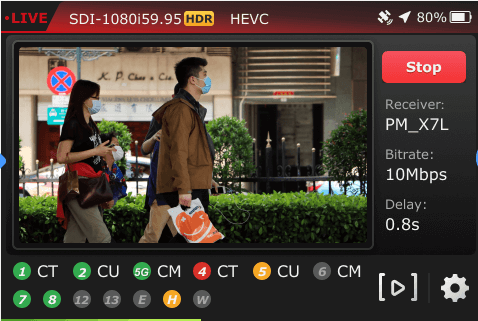
- To mark your in and out points, tap the Mark In button.
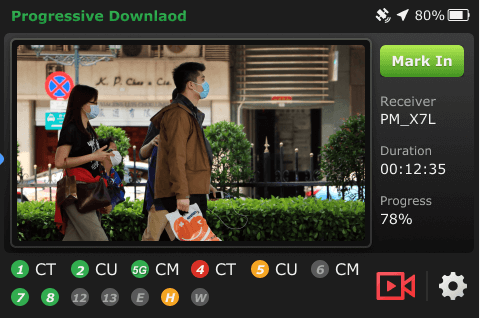
- Tap the Mark Out button.
- The camera
 icon and “Progressive Download” in the control bar are red when live with a receiver.
icon and “Progressive Download” in the control bar are red when live with a receiver.
Note: The marked clips will not be transmitted during live streaming.
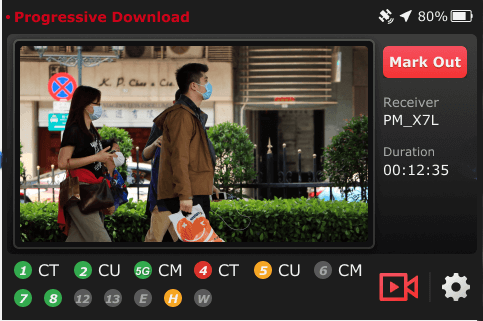
- Tap the gear icon, then tap the Transfer tab to check the status and completion percentage on the transfer interface. Clips in the Ongoing list have not been processed.

- Tap the Home button to return to the Progressive Download interface.
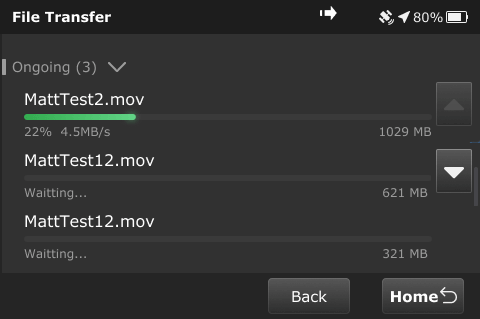
- Tap the camera
 icon.
icon. - When the live stream has stopped, tap the Stop button.

- Swipe the Slide to stop live slider. The transfer will start automatically.

- When the live stream stops, the camera icon is no longer red. The previously marked segment has now been transferred.
- Tap the gear icon.

- Tap the Transfer tab, your clip moves into the “Upload Complete” list.
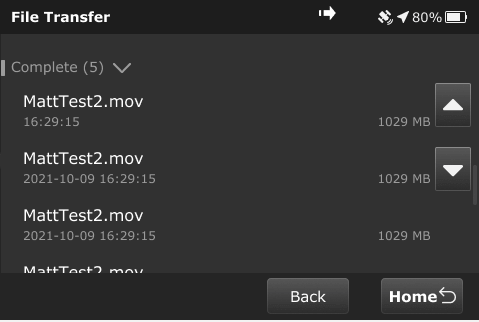
Your clips will automatically display in the download list on the receiver side.
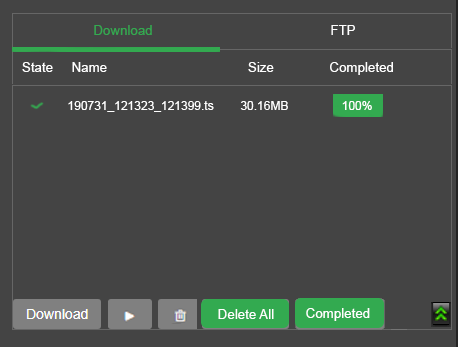
Disabling the Progressive Download feature
- Select Progressive Download from the drop-down menu to disable the Progressive Download feature.
- Make your “Control” changes:
- Camcorder: Tap the Camcorder button.
- Pack: Tap the Pack radio button.
Note: Tap the Upload tab to change the receiver.
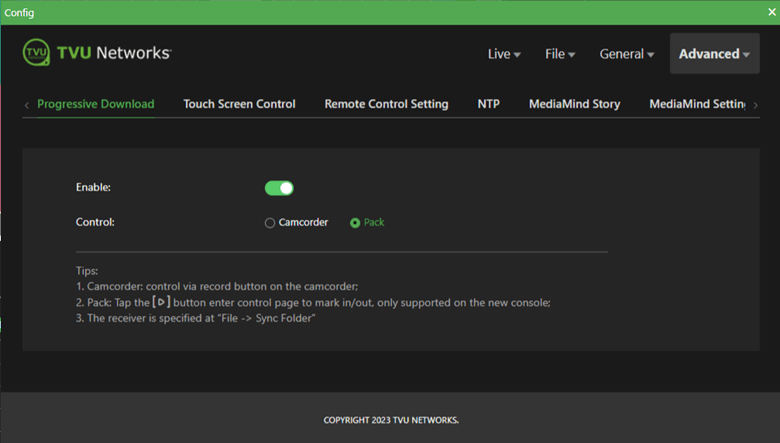
- To disable Progressive Download, move the slider to the left until it turns gray for each control selection.
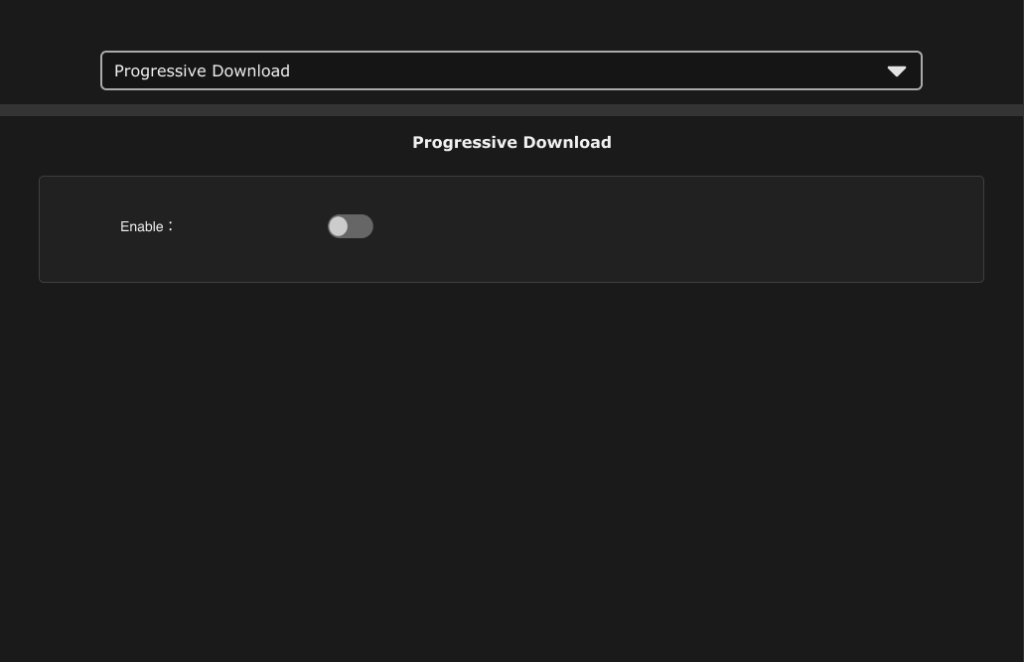
RVF tab
The return video feed type setting is accessed from the RVF tab.
- Tap the RVF tab.
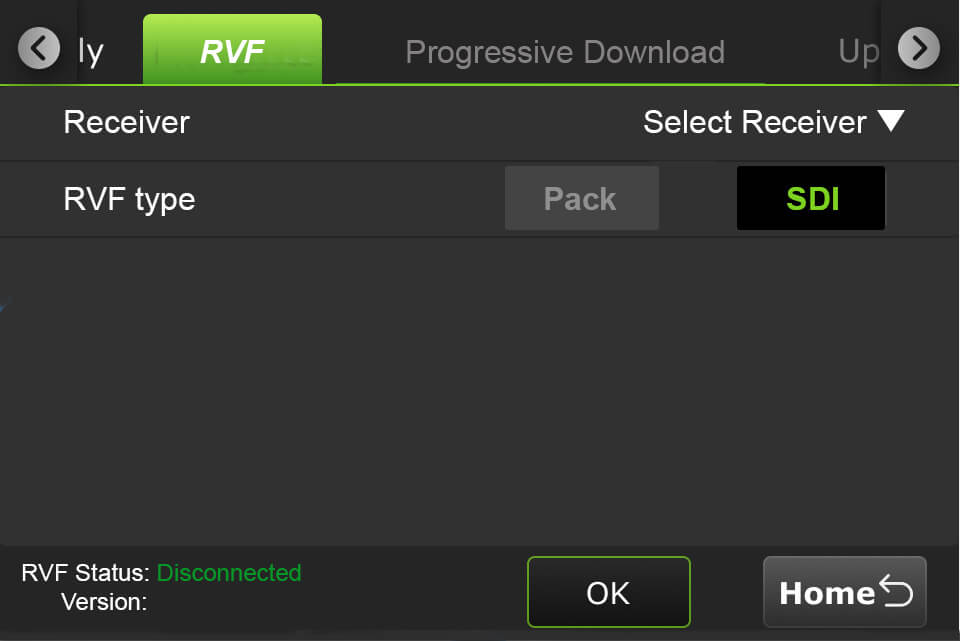
- Select a receiver from the drop-down menu and select the RVF type. Then, tap the Start button.
- Tap the Home button to return to the RVF control screen.

Upload tab
Using the Upload tab, A user can upload files from a USB flash drive to a Receiver:
- Tap the Upload tab.
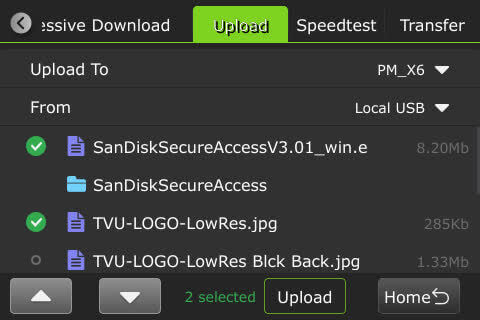
- Select a receiver from the “Upload to” drop-down list. Then, select a USB source in the “From” drop-down list.
Transfer tab
To view file transfer status, including progressive download, download, and Auto Sync, complete the following steps:
- Tap the Transfer tab.
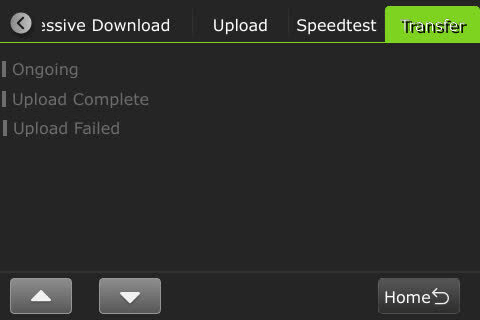
The following prompt displays when the file is being transferred when shutting down. The File Transfer window displays.


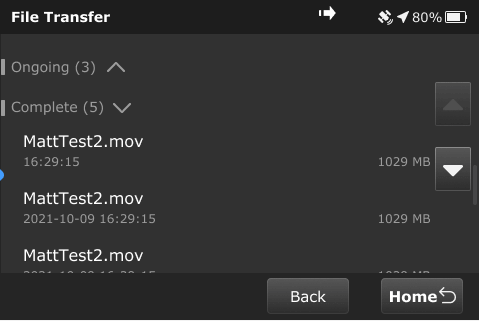
The following dialog displays if file transfers are in progress when powering off the device.

Chapter 6 – Advanced Configuration – New User Interface
This chapter explains advanced configuration procedures when using the new interface.
TVU One hotspot features
Wireless monitoring and control
By connecting to the TVU One’s hotspot, a smart device can monitor and control the TVU One transmitter wirelessly. There are two hotspot connection methods available:
- Scanning a QR code
- Entering the network name + password login
TVU One status monitoring and control using a Web browser, iPhone, or smart mobile device
The TVU Transmitter’s operational status can be monitored, and various transmissions can be controlled from a Web browser. This interface can be accessed using a standard web browser connected to the TVU One hotspot USB port on the side transmitter panel.
Connecting the TVU One to the internal hotspot
Complete the following procedures to configure the TVU One to the internal hotspot using your iPhone or smart mobile device.
Configuring the TVU One transmitter for hotspot (optional)
- Search for the hotspot on your iPhone/smart device. Then, when prompted, enter the case-sensitive SSID:
TVUPACK_XXXX
(Where X is the last 4 digits of the transmitter’s PID)
The default password is the last 8 digits of the TVU One PID
Note: All password characters are uppercase. The password can be changed in the Web UI if desired.
- Connect to the SSID using your iPhone/smart device. Refer to the following examples of how the status screens display on a smart device Web browser.
- Once the connection is established, Whether it is connecting to the device’s hotspot or through an Ethernet connection, you can access the device’s configuration page by entering 192.168.4.1 in the browser address bar.
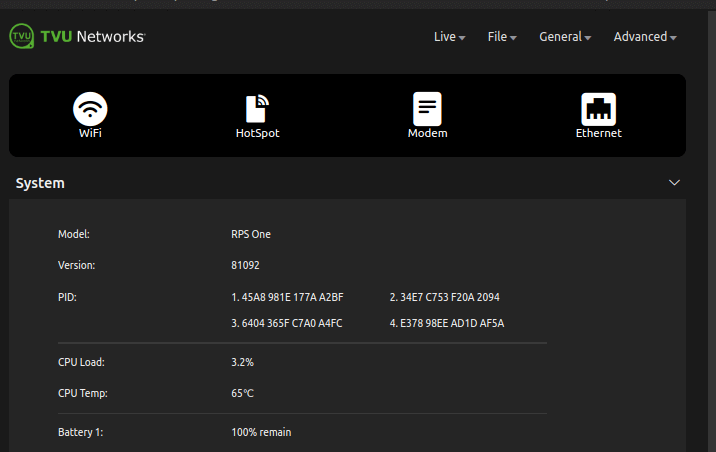
Connecting to the hotspot using the QR code method
To connect to the hotspot by using the QR code, complete the following steps:
- Tap the gear icon to open the Settings screen.

- Tap the Wi-Fi tab.
- Use your smart device to scan the Hotspot QR code.
Note: Connection is automatic; no password is required when using this method.
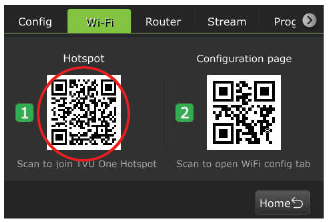
- Once the connection is established, scan the Configuration page QR code. This will display a Web page containing the Pack’s status and settings.
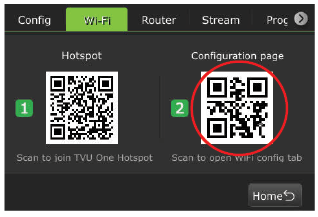
When connected to a GPS device or Partyline session, icons display at the top of the status screen next to the battery status.
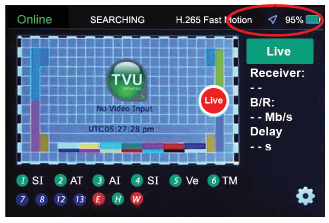
Router setting
To access the Router settings, complete the following steps:
- Tap the gear icon to open the Settings screen.
- Tap the Router tab. If the router setting is in the ON position, the following screen displays.
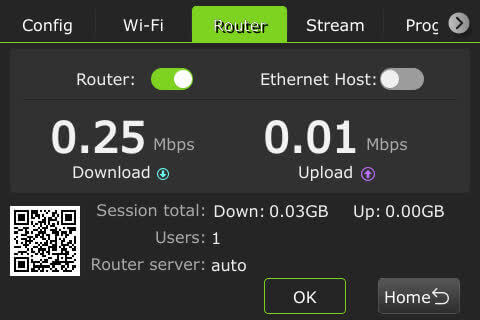
- If the router setting is OFF, the following screen displays.
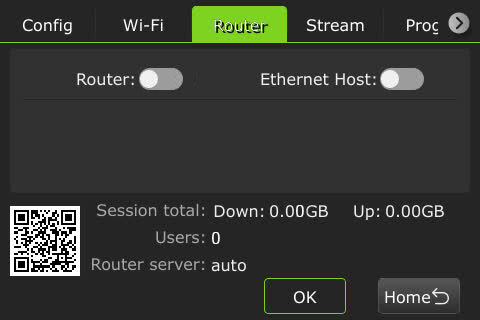
TVU Router feature (client connections)
If higher bandwidth is required when using a hotspot, the optional TVU Router feature can be enabled to allow speeds of up to 200 Mbps to clients connected to the TVU Pack.
- In the General > Network tab LAN Settings status panel Router menu, select Auto to enable the Router.
- Enter the IP address and Subnet Mask. Then click Apply.
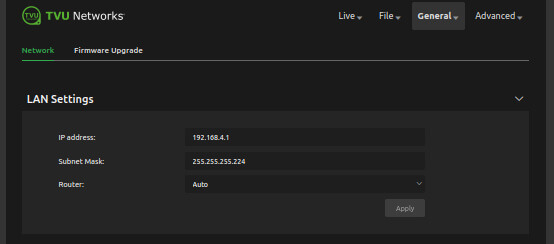
- Connected Clients are displayed in the Hotspot panels’ Connected Clients device list to confirm your settings.
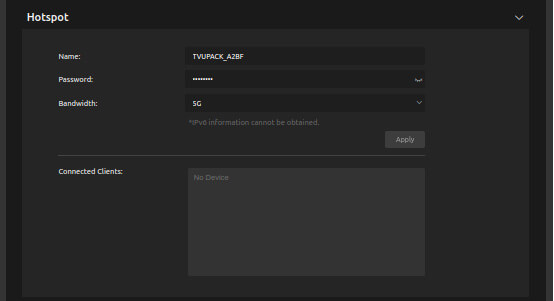
Speedtest feature
The Speedtest tab in the Settings menu allows the user to test the speed between the transmitter and receiver.
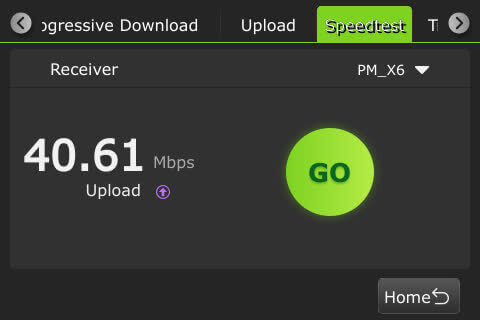
Returning to the previous console version
If desired, you can switch back to the previous console version after updating to the new console version.
To switch back to the previous console version, complete the following steps:
- Go to Settings and tap the Config tab. Then, tap About. (This will display basic Pack information.)
- At the bottom of the About screen, tap the Switch to the previous console button.

- Follow the prompt to reboot the Pack to activate the change.
New Web interface design and features
The v7.3 and above web interface has the following new configuration panel design and added features. If you are running an earlier version, the previous design will display as default.
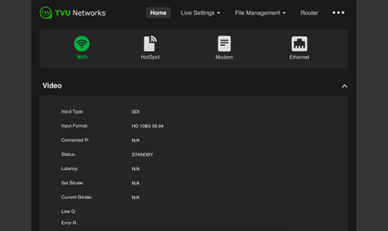
USB WiFi adapter feature
Users can create additional WiFI connections with additional USB WiFi adapter support. Users can enable or disable WiFi from the UI. The WiFI will automatically redial if network connectivity fails.
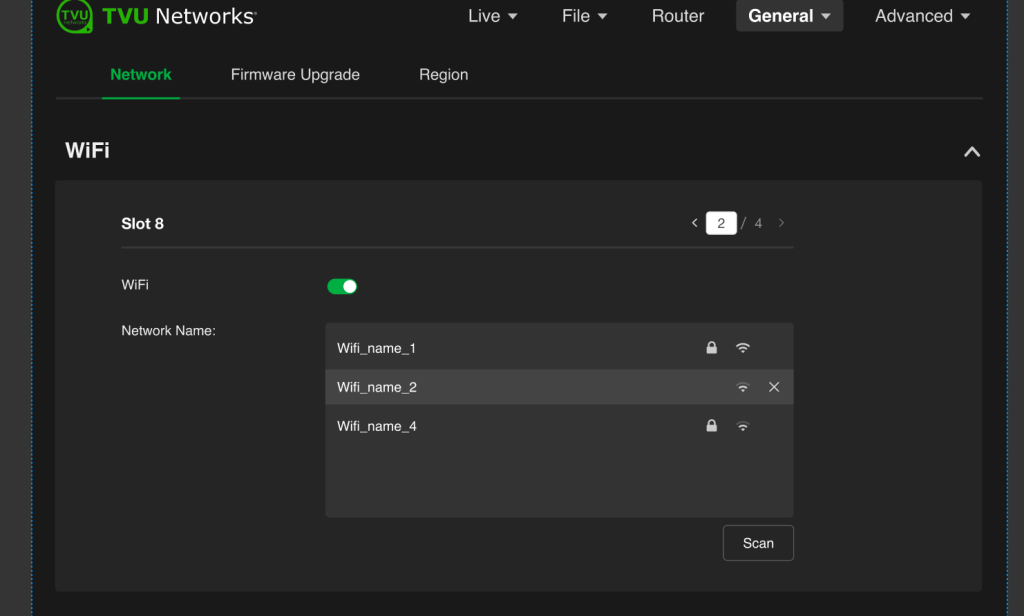
VLAN and Switch modes
The VLAN mode feature connects to the receiver’s VLAN without having a router data plan. Go to Menu > General > Network > VLAN to access VLAN mode.

Configuration page – VLAN and Switch modes
A LAN Setting has been added to the General > Network tab, which manages the device configuration page access address and IP range for connected devices via Router, Hotspot, and Ethernet. The “Router” field represents the server that distributes IP addresses to devices.
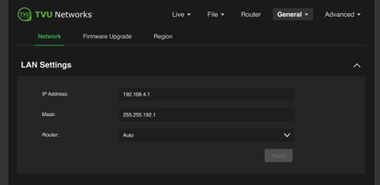
Devices with the VLAN feature can create a VLAN switch mode and build a LAN using VLAN. In this mode, the device hotspot is only available when it acts as a DHCP Server.
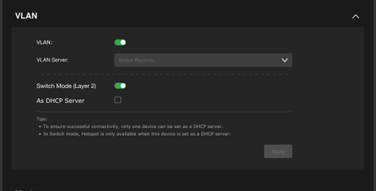
Similarly, devices with the Router feature can create a Router Switch mode and build a LAN using Router. In this mode, the device hotspot is only available when it acts as a DHCP Server.
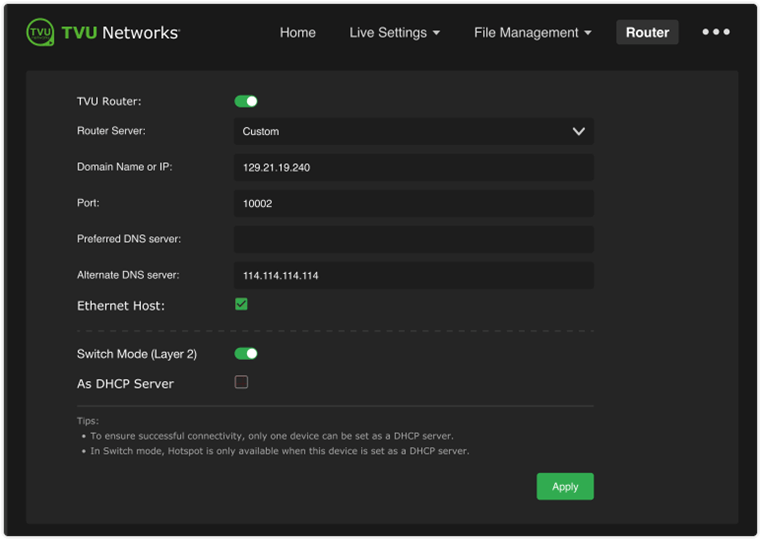
When VLAN or Router is enabled, the value of “Router” in the LAN Setting will be automatically displayed as “Router”, and it will go through the Router Server.
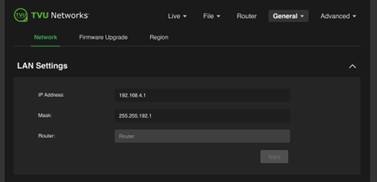
TVU One LCD Screen – VLAN and Switch modes
If the user wants to control the Switch mode on the LCD screen, ensure the device has enabled VLAN or Router functionality. Then you can turn on or off the Switch mode on the Config > Switch page of the device’s LCD screen. This page lets you check if the device is set up in Switch mode using VLAN or Router.
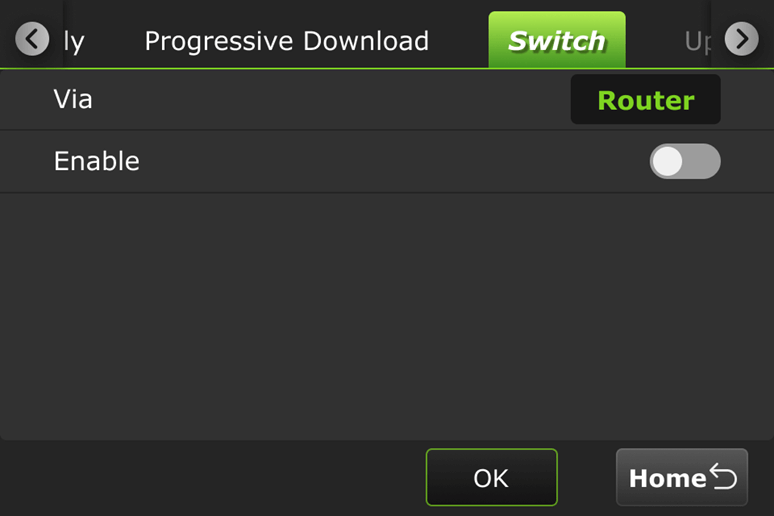
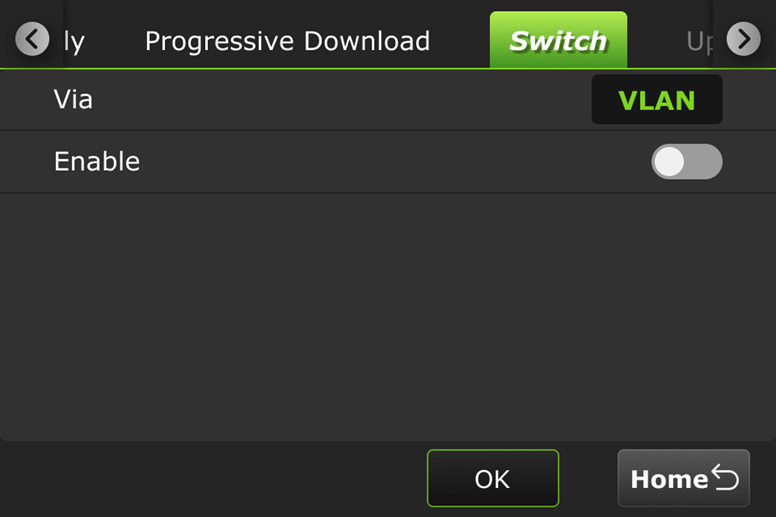
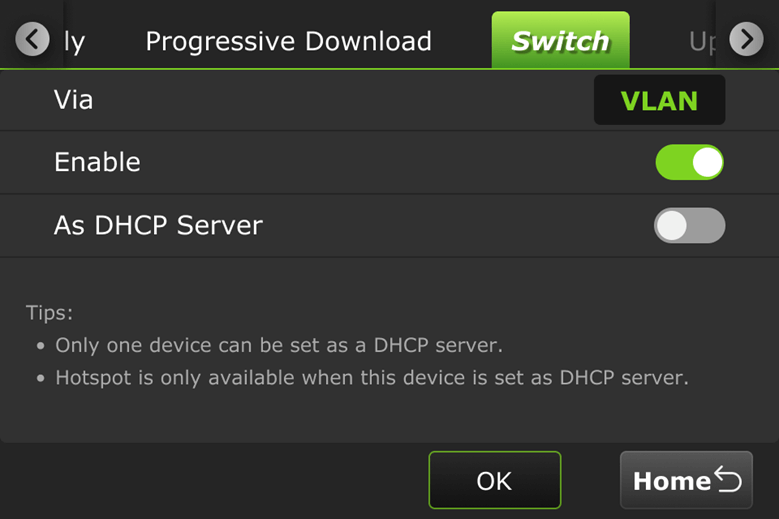
If VLAN or Router is not enabled, it is necessary to log in to the device’s configuration page and enable it to set it on the LCD screen.
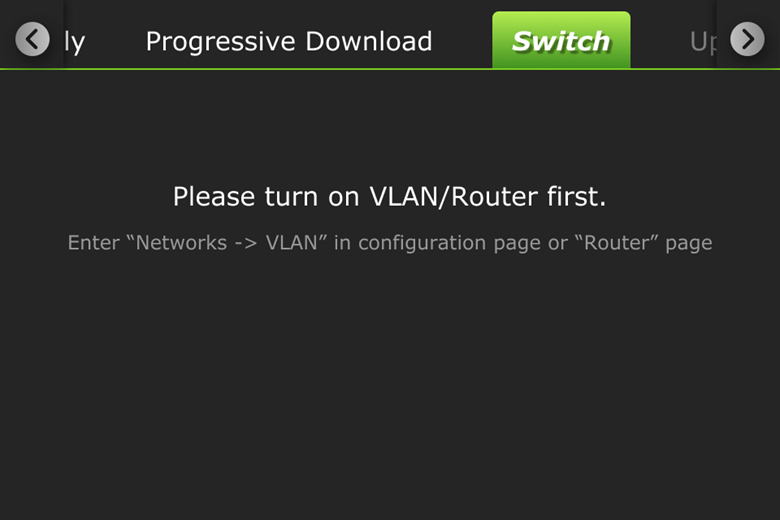
IPv6 support – Configuration UI
If the device is authorized for the IPv6 feature, go to the local configuration service and open the General > Network > Ethernet page. The Ethernet module will have an added parameter called Configure IPv6. Devices without IPv6 authorization only have IPv4 configuration parameters by default.
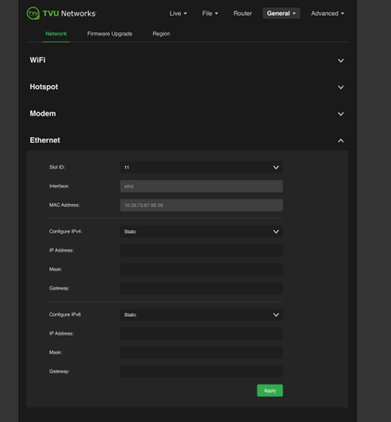
If the device uses an IPv6 network, the IPv6 address of the slot and the link’s latency can be seen in the network module on the home page.
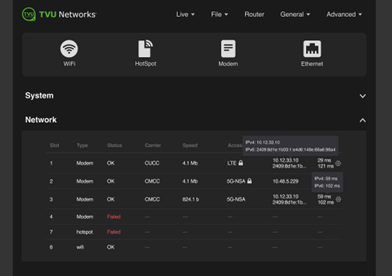
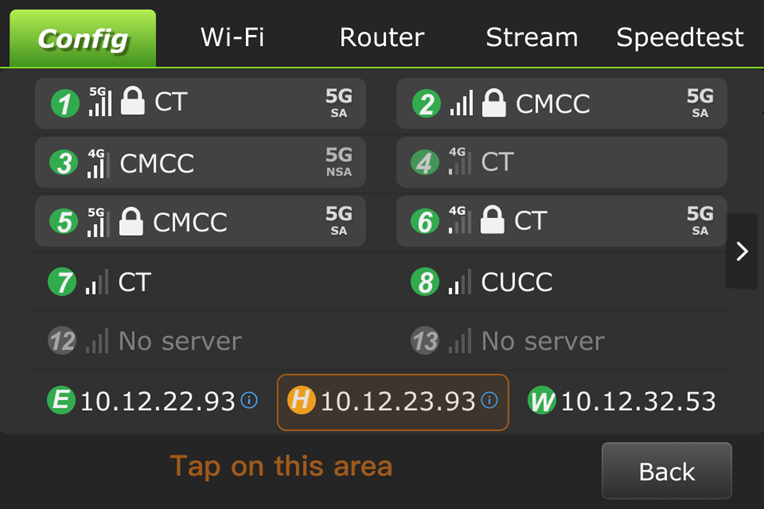
If this Slot is using IPv6, then click on its display area to view the specific IPv4 and IPv6 addresses.
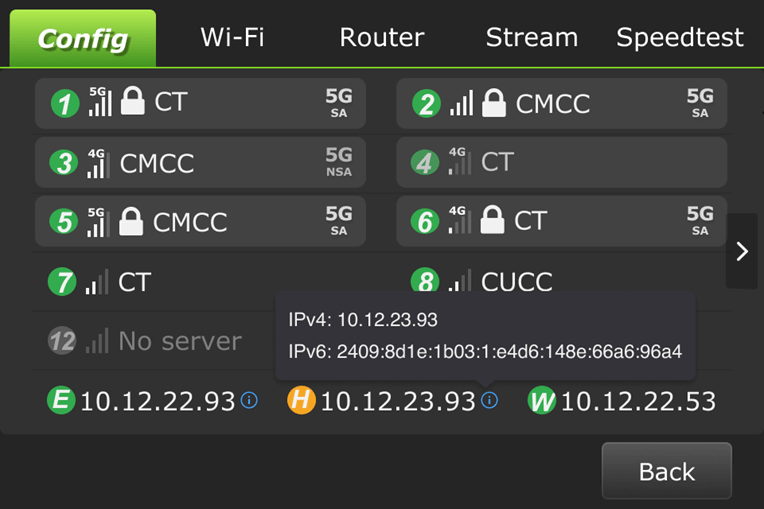
Access WiFi MAC Address, Modem IMEI, and SIM ICCID
In the configuration page, click the General > Network tab to view the corresponding information in the WiFi and Modem modules. To copy the IMEI and ICCID information, click the Copy icon.
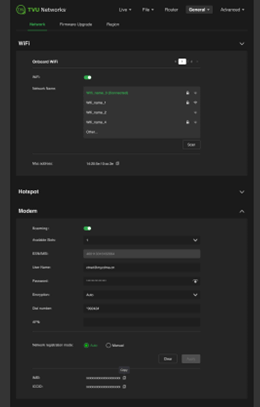
TVU One LCD screen
Similarly, If the device uses an IPv6 network, the LCD screen on the network module will display the Slot’s IPv6 address and link delay.
Self-check feature – from the Configuration UI
To check the health status of the device from the config page, complete the following steps:
- Click the Advanced Setting > Self-check tab and select the modules you need for testing. There are three modules: basic (basic functions of the device), Video, and network module.
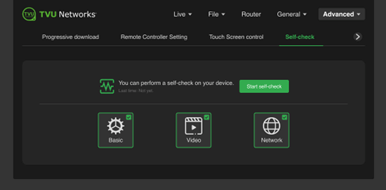
- Click the Start self-check button, the detection will begin. You can see the device’s detection process and progress on the page.
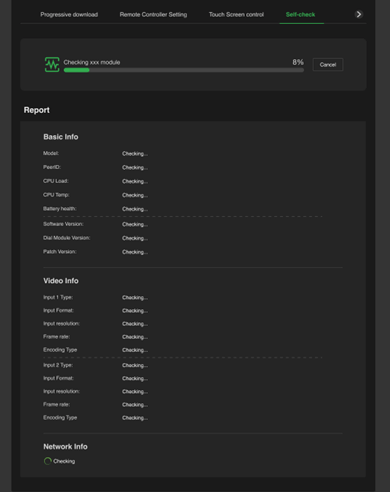
The final test results will be displayed at the top of the page, and detailed status and information can be seen in the corresponding module. The data and device detection results will be synchronized to the company’s server for subsequent use.
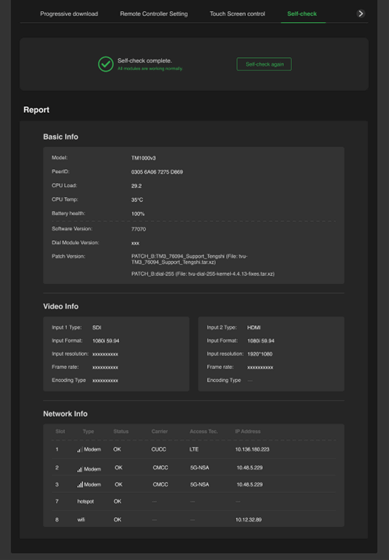
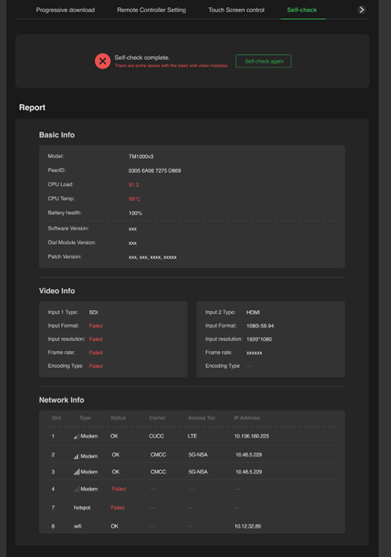
Self-check from the LCD screen
The final test results will be displayed at the top of the page, and detailed status and information can be seen in the corresponding module.
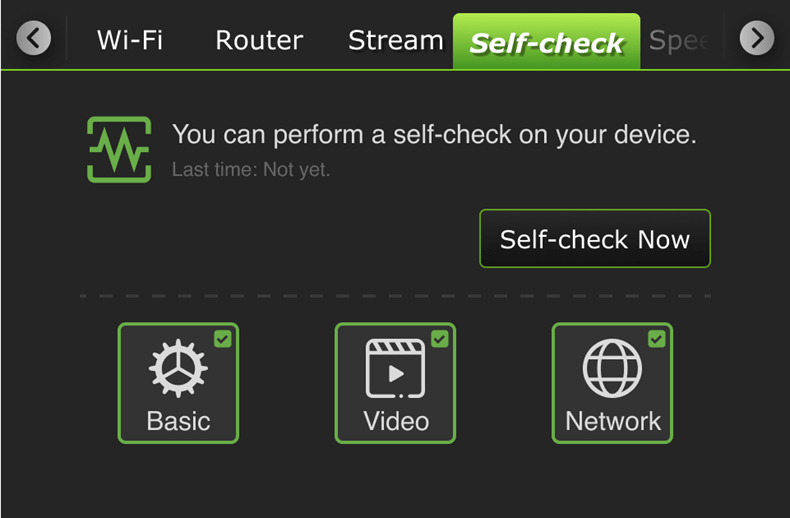
After clicking the Start self-check button, the detection will begin. You can see the device’s detection process and progress on the page.
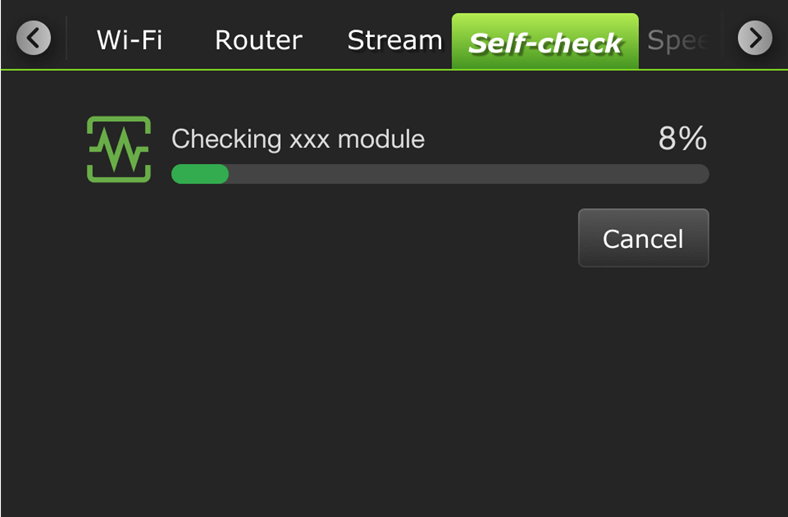
The final test results will be displayed at the top of the page. The data and device detection results will be synchronized to the company’s server for subsequent use.
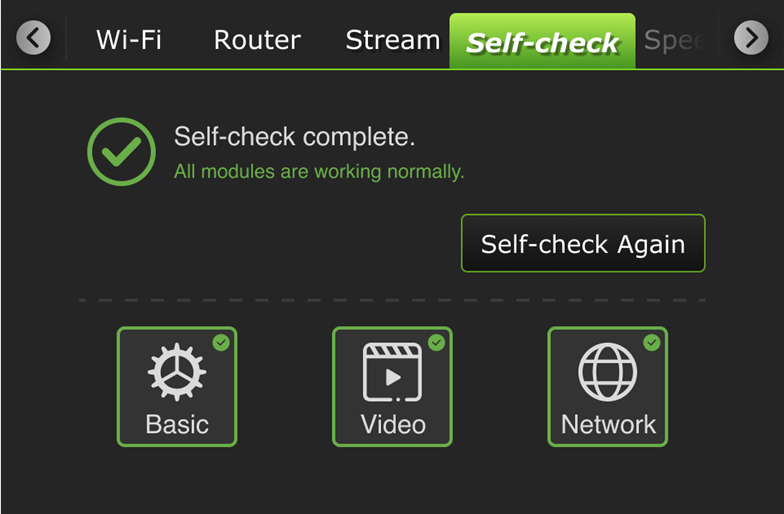
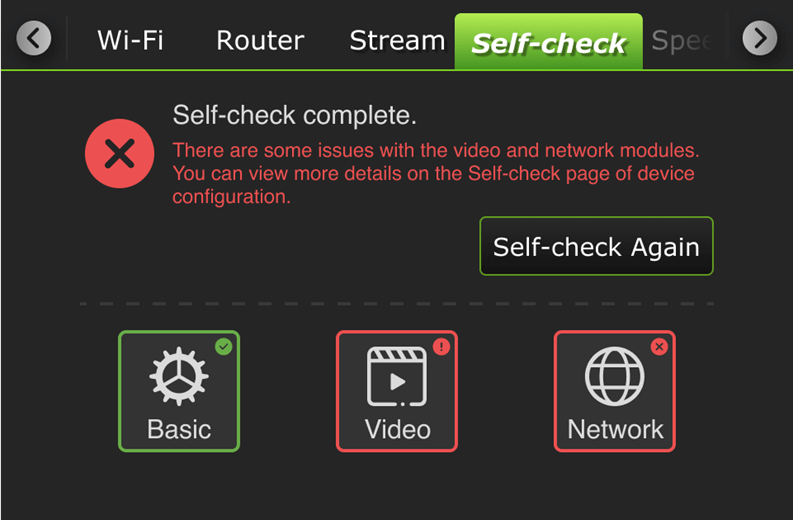
The data and device detection results will be synchronized to the company’s server for subsequent use.
RVF option
The built-in HDMI output for HDMI provides up to 1080p resolution and allows a user to send a confidence monitor or SDI source back to crews in the field. This on-board feature can now support viewing the return video feed using an iPhone and iPad.
Forced 3G/4G mode
When the forced 3G/4G mode is active, a padlock icon  displays in the Modem setting window.
displays in the Modem setting window.
Timelock function enhancement
A Timelock ![]() icon displays in the top bar to indicate when the function is active.
icon displays in the top bar to indicate when the function is active.

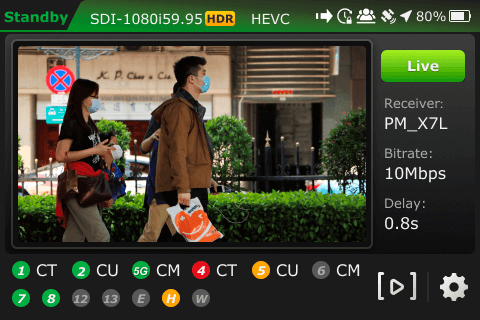
Partyline function indicator
When a Partyline session is active, the Partyline ![]() icon displays in the top bar.
icon displays in the top bar.
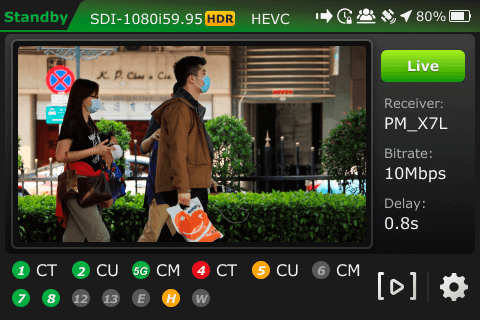
NTP host status feature
Users can access the NTP host status feature from the touchscreen display and the Web configuration page.
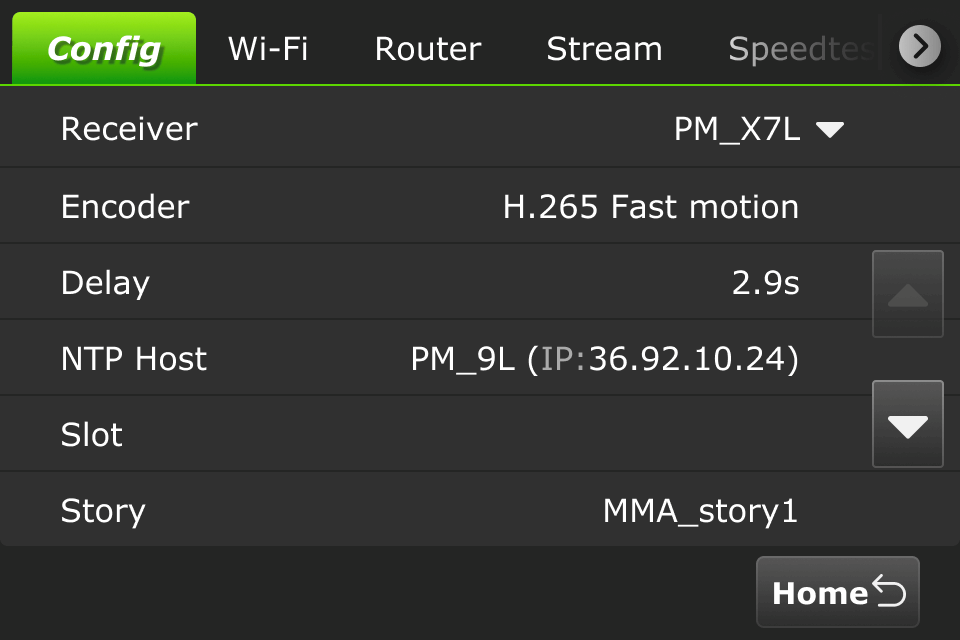
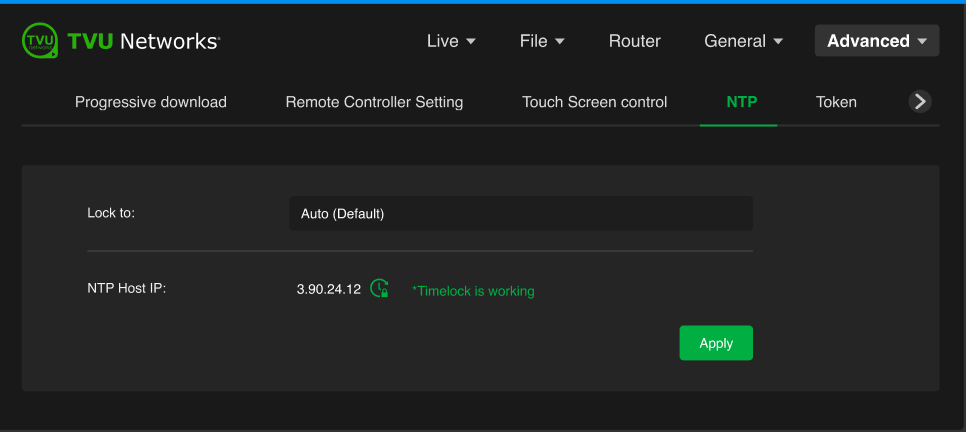
The v8.0 and later Web interface has the following new configuration panel design and added features to allow users to easily set up, monitor, and manage settings from a simple Web interface.
- Access the TVU One’s Web UI via the receiver’s built-in hotspot, Command Center, and/or WebR.
- Frequently used WiFi, hotspots, modems, and Ethernet configurations have dedicated shortcuts.
- Monitor the input on the touchscreen.
- Start/stop and configure the stream.
- Timelock technology ensures all sources are fully frame-synced automatically.
Use the Advanced Web interface to select the Live, File, General, and Advanced top menus to access the following configuration pages easily.
Live menu
Click Live > Encoder tab to configure video, audio encoding, and audio output mapping.
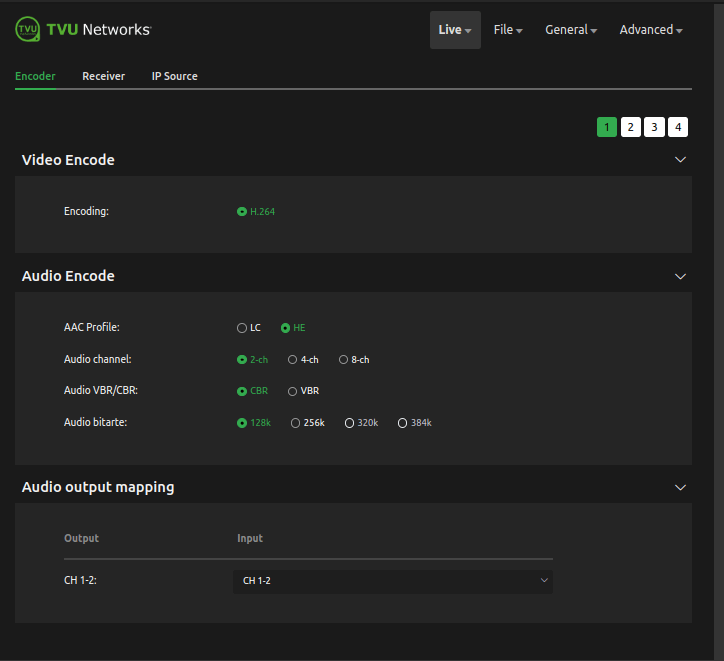
Click Live > Receiver tab to configure receivers.
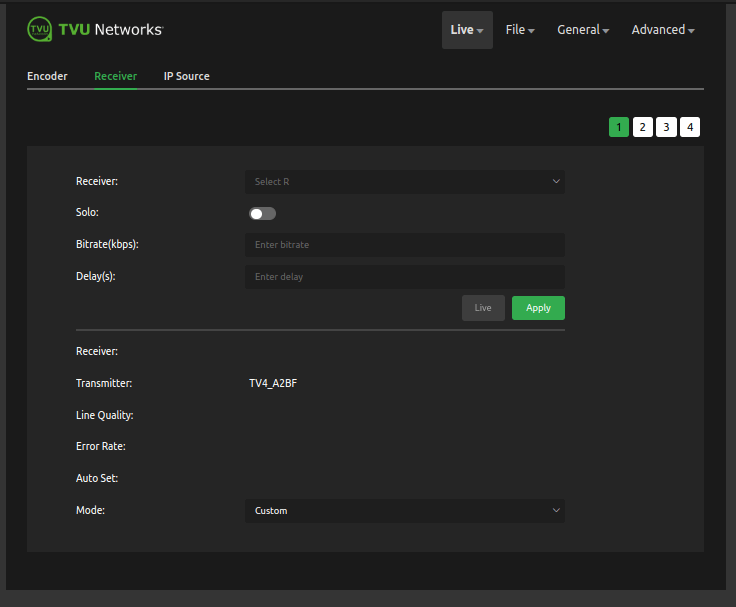
Click File > IP Source tab to add/view IP sources.
File menu
Click the File > File Uploader tab to choose where and where to upload files.
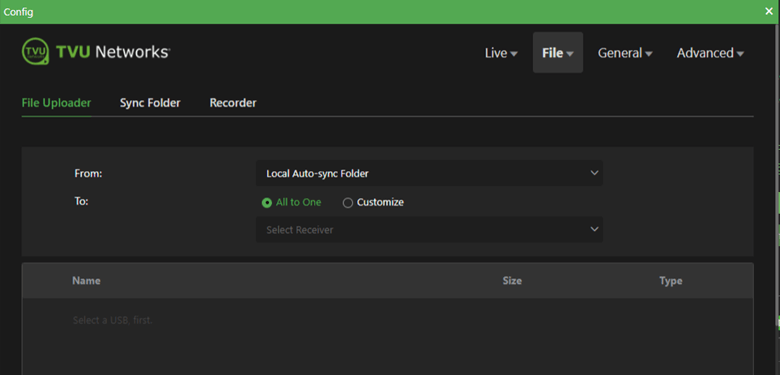
Click File > Sync Folder tab.
Use the Sync folder tab to transfer and sync files to a specific receiver. Refer to the “Auto Sync feature” for more information.
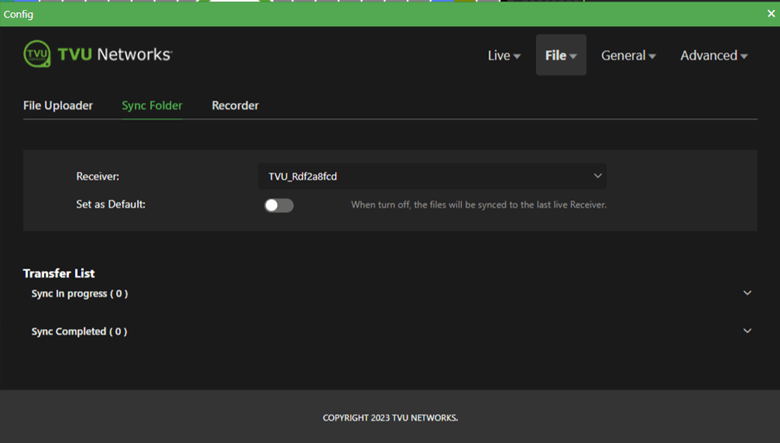
Click File > Recorder tab.
The Recorder tab allows users to select, mark, download, rename, and upload recorded files. Refer to “Working with recorded content” for more information.
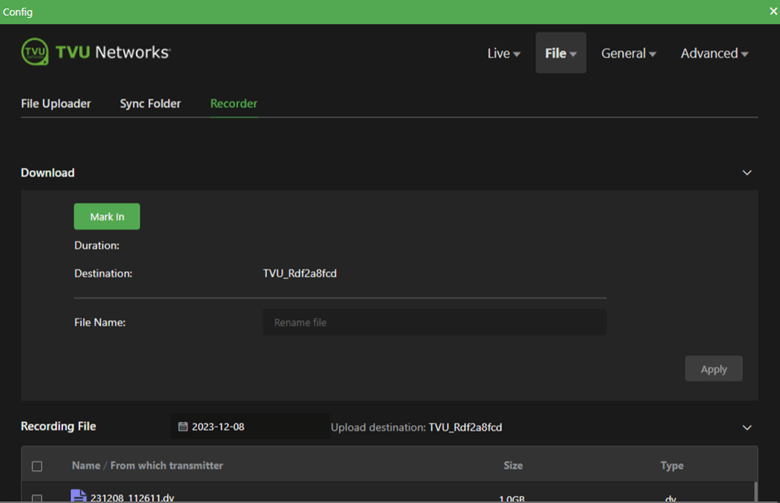
Users can monitor the upload and export file status.
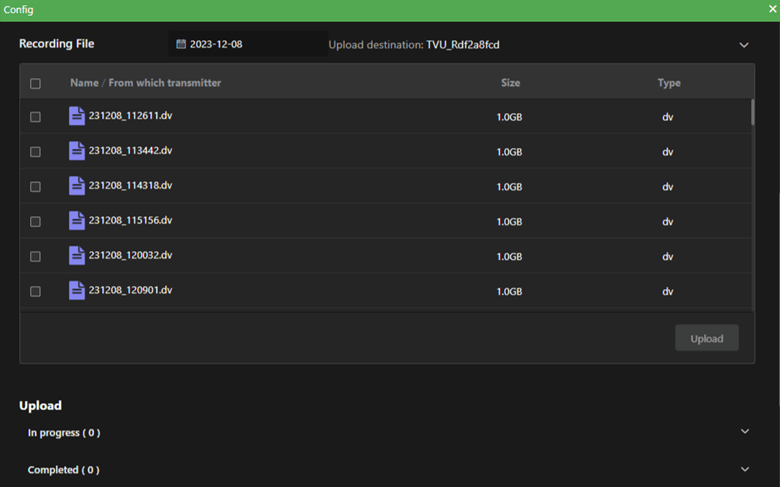
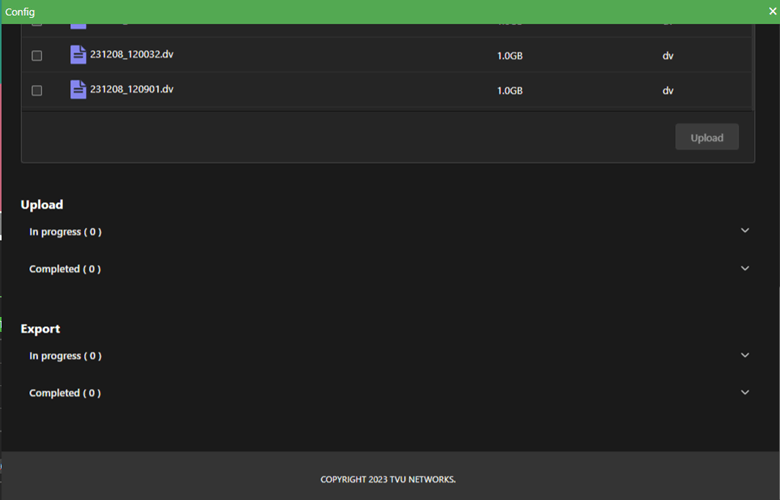
General menu
Click General > Network > LAN Settings.
In the General Network tab, users can configure their LAN Settings.

Click General > Network > VLAN.
The VLAN mode feature connects to the receiver’s VLAN without having a router data plan.
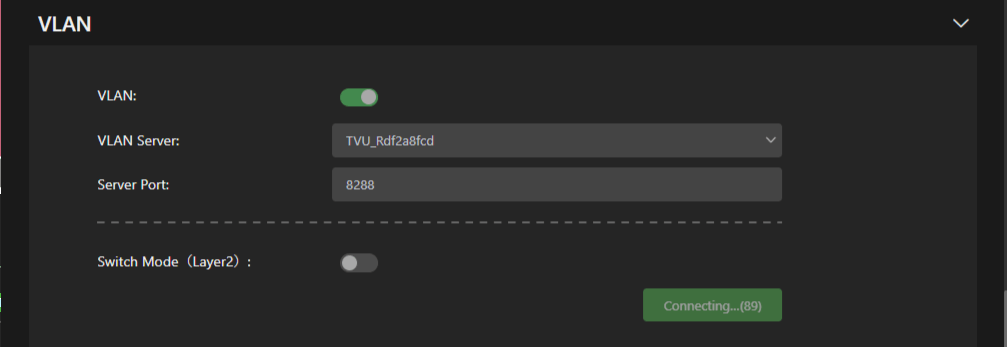
Click General > Network > Hotspot.
Hotspots for client connections can be configured in the Hotspot panel.

Click General > Network > WiFi.
Users can create additional WiFI connections with additional USB WiFi adapter support. Users can enable or disable WiFi from the UI. The WiFI will automatically redial if network connectivity fails.
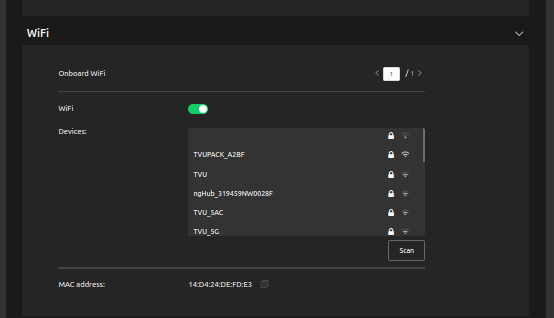
Click General > Network > Ethernet.
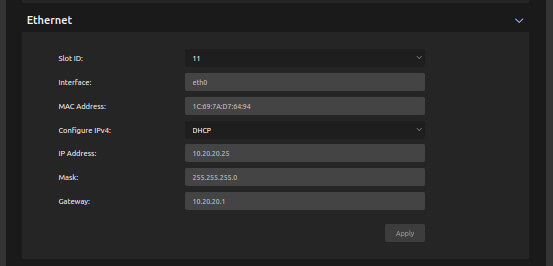
Click General > Network > Modems.
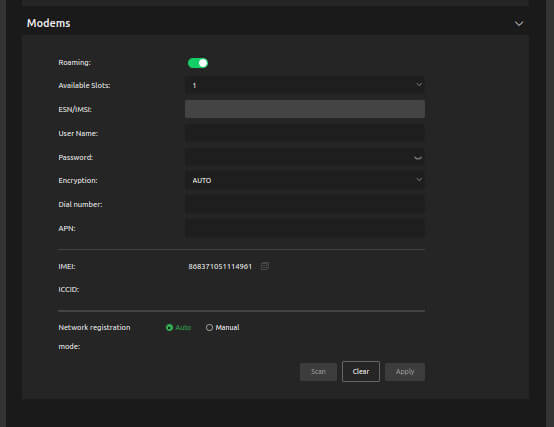
Click General > Network >Firmware upgrade.
Users can check for firmware updates in the Firmware Update panel. The following message displays when there is no firmware update available.

Advanced menu
Advanced Web interface configuration page:
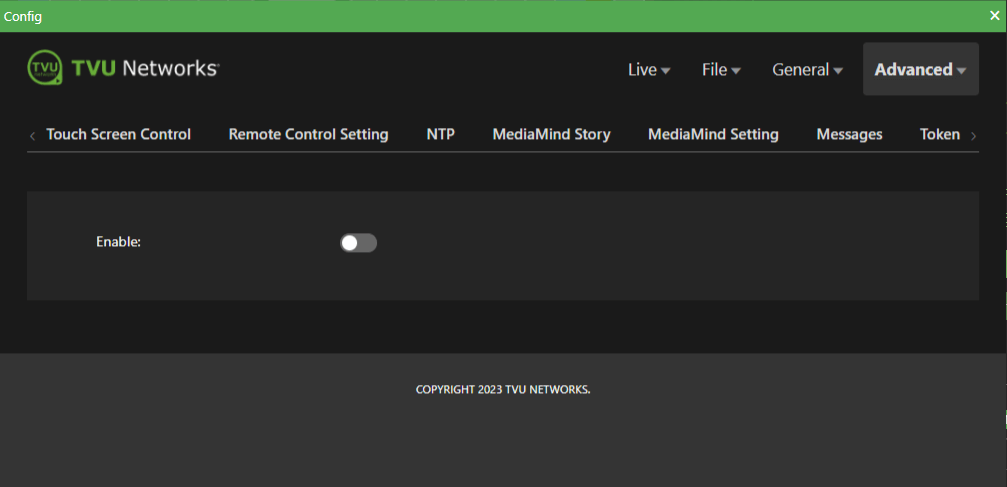
Click Advanced > Progressive Download tab.
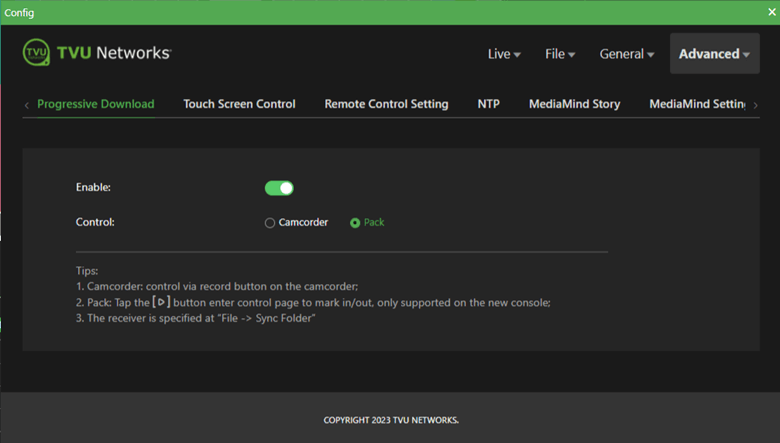
Click Advanced > Touch Screen Control tab.
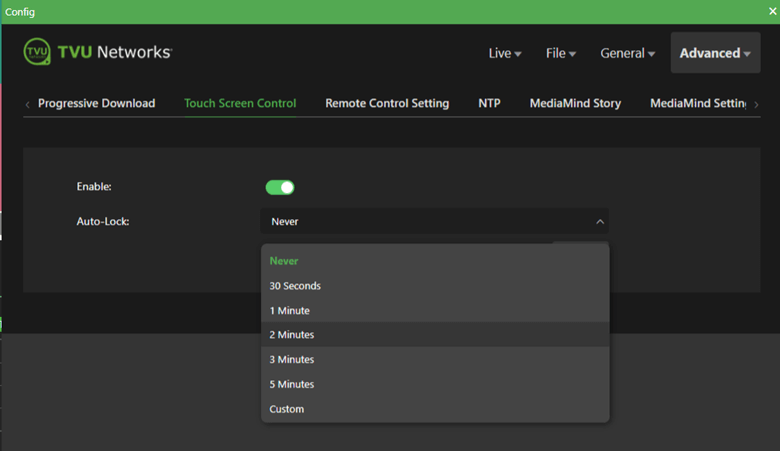
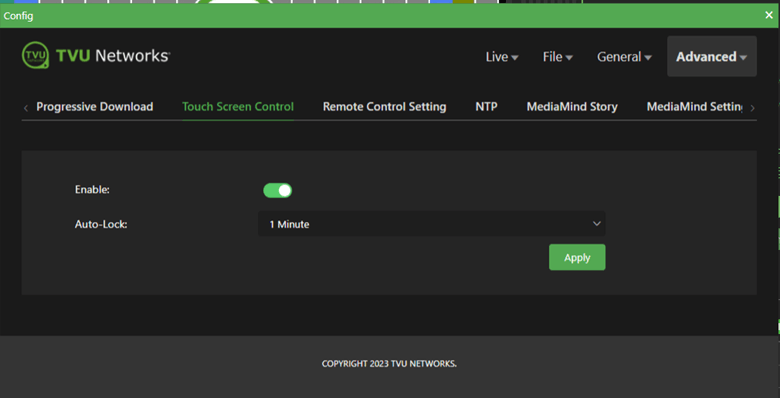
Click Advanced > Remote Control Setting tab.
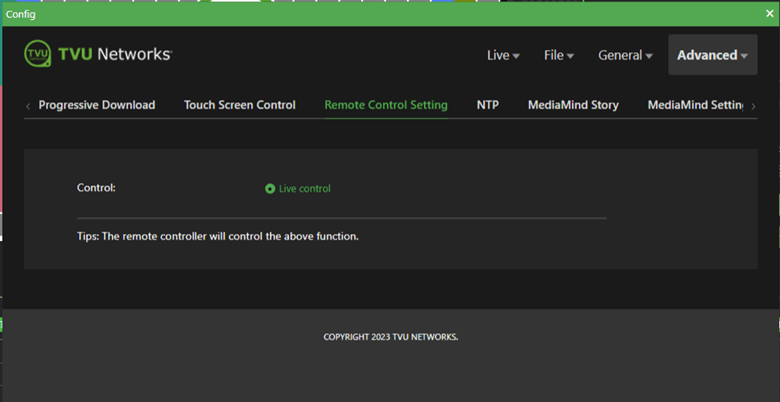
Click Advanced > NTP tab.
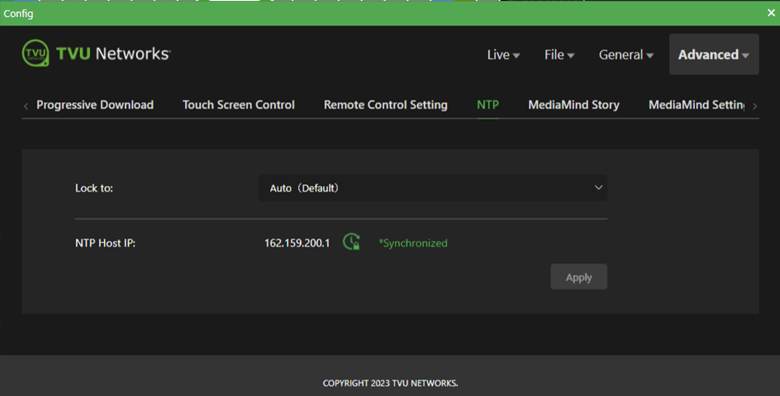
Click Advanced > MediaMind Story tab.
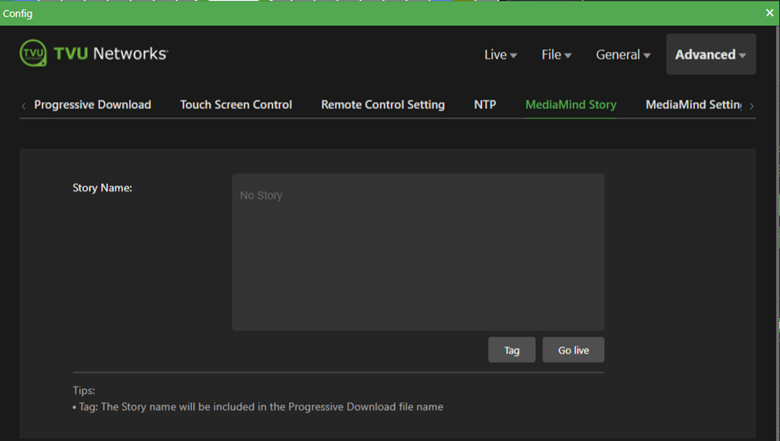
Click Advanced > MediaMind Setting tab.

Click Advanced > Messages tab.
Refer to “Messages feature” for more information.
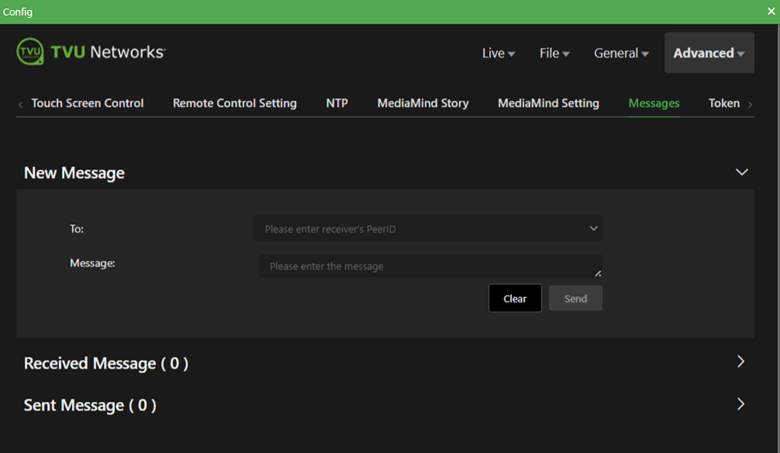
Click Advanced > Token tab.
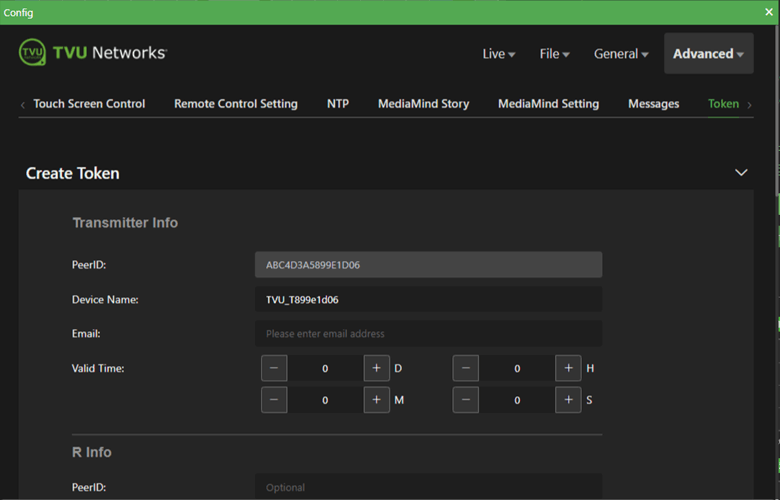
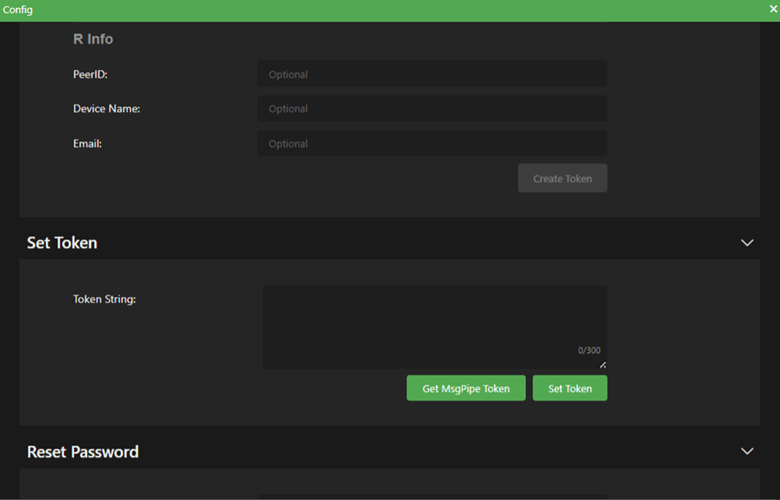
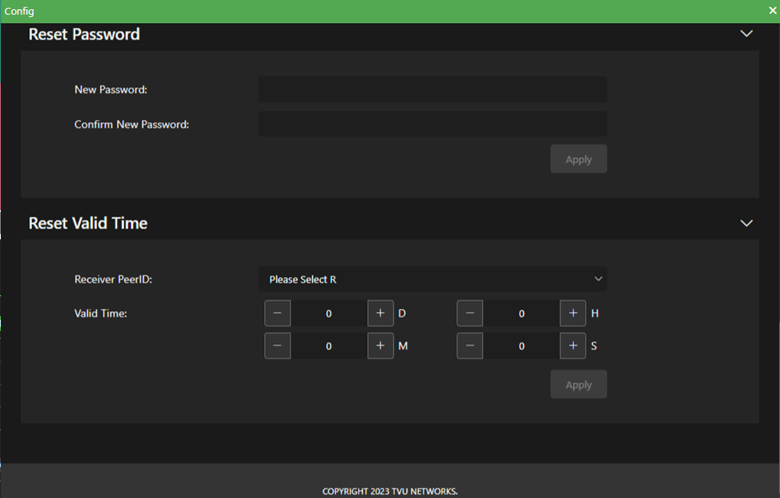
Chapter 7 – File-based workflows
This section provides information and instructions for file-based workflows. Topics in this section include dual-encoder operations, Auto Sync, using the recording function, file upload feature, and Download feature.
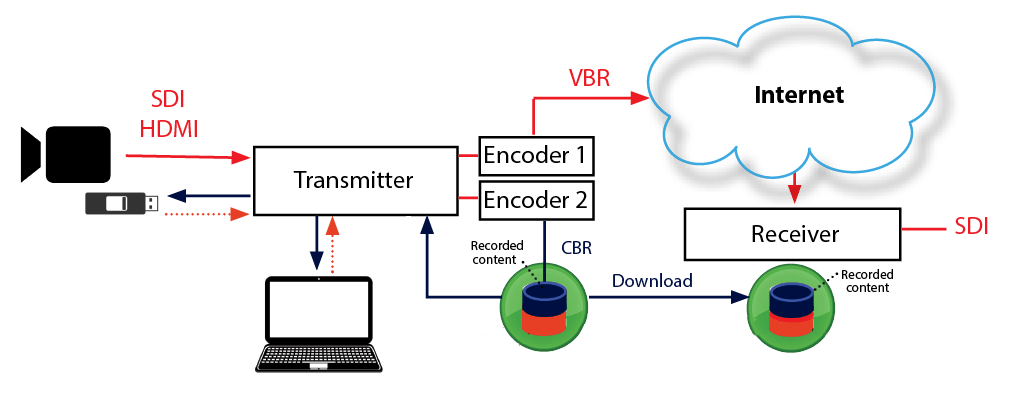
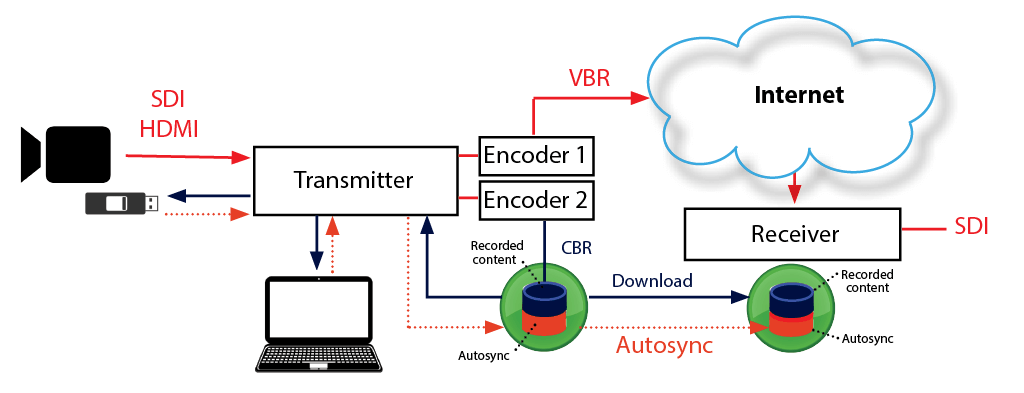
Dual-encoder feature
The optional TVU dual-encoder feature records a pristine, high-resolution copy of all detected video directly to the external SSD storage. Thus, no video is lost, even if the original transmission encountered difficulties.
The TVU One transmitter continuously records a high bit rate using a second encoder. The second encoder Is always on when the unit is powered and does not require manual configuration or power.
- A remote operator can then view and extract recorded content from the TVU Transmitter remotely using the receiver download feature.
- In addition, the local TVU operator can access the recorded content for editing purposes.
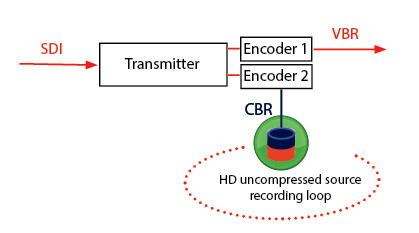
Auto Sync feature
Auto Sync is a high-speed file transfer feature that automatically pushes the files from the transmitter to the receiver using IS+.
There are two Auto-sync methods you can use to send files to the TVU receiver automatically:
- You can perform Auto sync by inserting a USB stick into the transmitter.
- You can use the TVU transmitter wireless hotspot feature to transfer files directly to the TVU transmitter for upload.
Using the Auto Sync feature with a hotspot (PC)
Complete the following steps to perform an Auto-sync file transfer using a wireless hotspot:
- Search for the hotspot on your laptop or smartphone. The SSID will be TVUPACK_XXXX.
(Where X is the last 4 digits of the TVU transmitter PID) - Connect to the SSID
- The password is the last 8 digits of the PID of the backpack (Note: All characters are uppercase)
- Once the connection is established, obtain the IP address in the Connection Details.
- Open file explorer, select Network, and enter the IP address. For example: \192.168.3.1
- The AutoSync folder displays (as shown in the following graphic). Drag and drop the files to be transferred into the AutoSync folder.
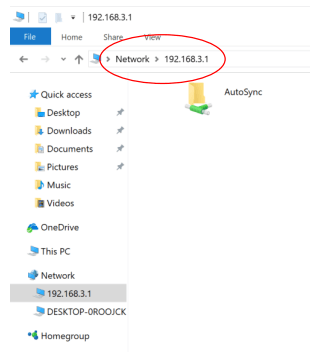
Using the Auto Sync feature with a hotspot (Mac)
Complete the following steps to perform an Auto-sync file transfer using a wireless hotspot:
- Search for the hotspot on your laptop or smartphone. The SSID will be TVUPACK_XXXX.
(Where X is the last 4 digits of the TVU transmitter PID) - Connect to the SSID
- The password is the last 8 digits of the PID of the backpack (Note: All characters are uppercase)
- Go to Finder and select Connect to Server under the “Go” tab.
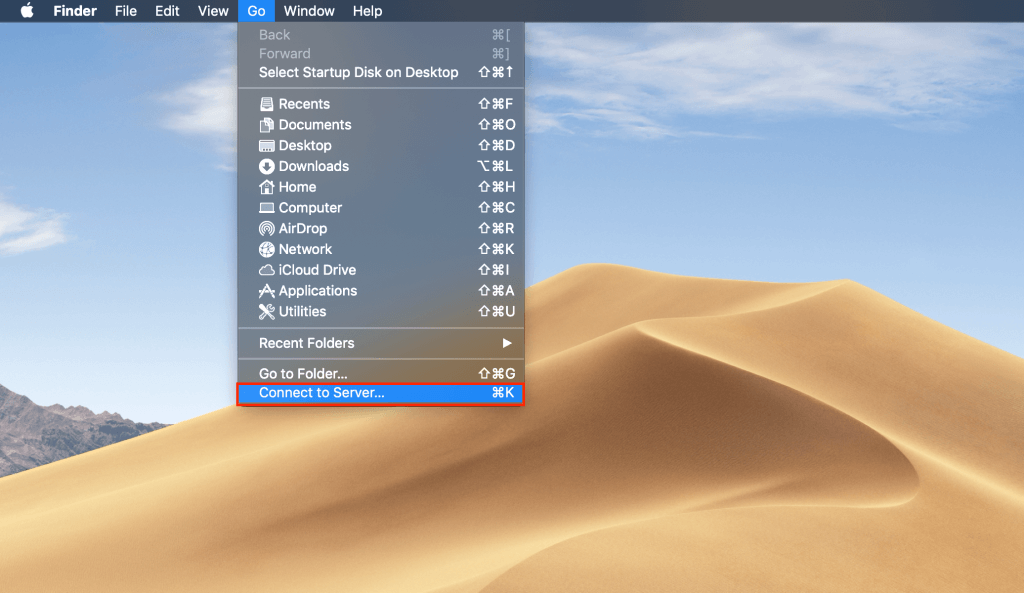
- Enter “192.168.3.1” in the “Server Address” field and click Connect.
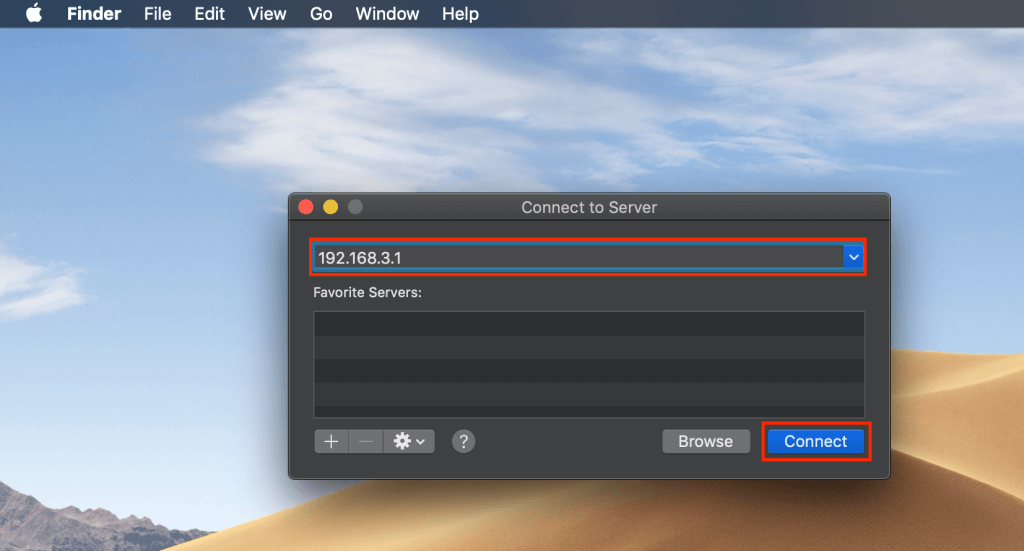
- The “Connect As” pop-up menu displays. Select Guest and then Connect.
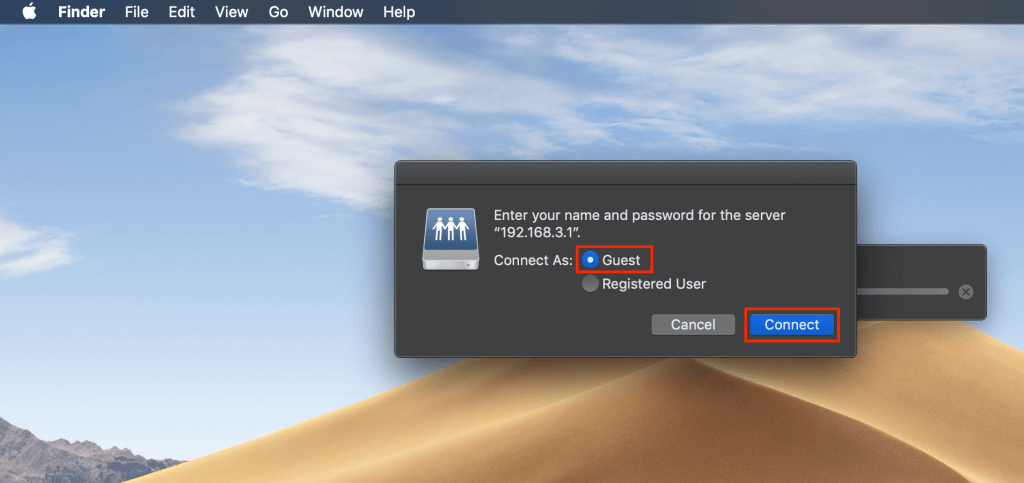
- Move files you wish to be sent using TVU Auto Sync to the “AutoSync” shared drive icon on your desktop.
Using the Auto Sync feature with a USB stick
The Auto Sync feature allows you to transmit wireless digital content from the TVU transmitter to the TVU receiver using a USB memory stick.
The TVU transmitter will auto-detect the memory stick and automatically transfer the contents to its internal SSD hard drive. The content will then be available for wireless transmission to the TVU receiver.
Attention: The supported disk format is FAT 32 only.
To perform an Auto Sync using a USB memory stick to a TVU One transmitter, complete the following steps:
- Create a directory named “autosyncimport” in the memory stick.
- Copy the content you want transferred into the “autosyncimport” directory.
- Plug the memory stick into any spare USB port on the transmitter.
- Monitor the file upload status on the TVU transmitter’s LCD screen. Do not unplug the USB memory stick during the file upload, as this may cause the system to malfunction.
Note: The TVU transmitter cannot be “live” to use this function.
Accessing stored content
Local Download of Recorded Content to a USB Memory Stick:
Connecting a USB memory stick (FAT 32 only) to a TVU transmitter while the video source is disconnected will transfer the entire video content of the last session to the memory stick in an NLE-compatible format.
Additionally, on the web-based monitoring and controls interface, the Recording screen (explained in this section and “Working with recorded content”) will list the recorded sessions on the TVU transmitter SSD that are available for download and explain how to use the following three functions that are available in the Recording screen:
- Export and play
- Upload
- Mark in and Mark out
Export and Play functions:
The Export function allows the user to extract recorded clips listed in the recording screen from the transmitter to a local USB drive. To use the Export function, complete the following steps:
- Click the File drop-down menu and select the Recorder tab.
- Select the check box next to the desired recording(s).
- Click the Export button. Users will be warned if not enough space is available on the memory stick.
- Select a clip from the list to preview recorded content and click the Play button.

Note: Playback is only available on iOS devices
Once a file has been selected to download to the USB, a “Exporting” message will display while the file is exported, and a “Complete” message will display when the process is complete.
Note: The TVU transmitter cannot be “live” to use this function.
Upload function
The Upload function in the File > Recorder tab will use the Auto Sync feature to push recorded clips from the transmitter to a remote receiver. Refer to the “File Uploader feature” for more information.
Working with recorded content
Mark In and Mark Out function
The Recording screen’s Mark In and Mark Out functions are used to explicitly select a portion of a live ingest for extract or upload.
Complete the steps in the following procedure to use the Mark In and Mark Out functionality in the File > Recorder tab to isolate and copy a live video clip to a USB thumb drive or to upload directly to a receiver using the Recording status window:
Note: The TVU device is always recording when it is powered on and a valid video source is connected.
- Click the File drop-down menu and select the Recorder tab.

- Click the Mark IN button to mark the IN point of a segment in the recorded video on the TVU Pack.
- Click the Mark OUT button to mark the OUT point of a segment in the recorded video on the TVU Pack.
Note: After the IN and OUT points are identified, it is possible to play the clip, copy the clip locally to an inserted USB thumb drive, or upload it directly to the selected receiver.
- Enter a specific name for the recorded segment in the File Name field.
- Click the Apply button to add the recording to the recorded segment list at the bottom of the Recording status window.
- To search for and display a recorded video segment by date, click the calendar icon at the top of the recorded file list and select a recording date to display the recording in the list.
- To select and play a preview of a specific video recording in the list, click the check box next to the recording and click the Play button.
- To copy a clip from the list to the transmitter, insert the thumb drive into the One’s USB port, and click the recorded file check box in the list. Click the Export button.
- Click the Upload button to transfer the copied recorded file from the transmitter to the default receiver (designated in the receiver window).
File Uploader feature
The TVU One’s File Uploader panel allows you to upload files to a particular receiver using the Auto Sync feature.

Using the File Uploader panel
Complete the steps in the following procedure to select a specific receiver to upload files from:
- Click File > File Uploader.
- For each file uploaded, select the specific receiver to which you would like the files uploaded from the Select Receiver drop-down menu.
- Once the receiver is selected, click the File > Sync Folder tab and select a default receiver from the drop-down menu.

- To make your selection the default receiver, Move the Set as Default slider to the right until green. This will enable all future files to be uploaded to the default receiver.
Note: For instructions about uploading files from a TVU Transmitter to the TVU Receiver, refer to Chapter 7 “Using the Auto Sync File Transfer with a hotspot”, or “Using the Auto Sync feature with a USB stick” for more information.
Note: The TVU transmitter cannot be “live” to use this function.
Download feature
The download (pull) RX feature lets the operator see and extract recorded transmitter video remotely.
The download local transmitter (T) feature allows local access to recorded content for editing purposes.
Refer to the Server hardware guide for detailed information about the Download feature and its functionality.
Progressive download feature
The Progressive download feature allows real-time simultaneous download streaming from a file-based clip. This feature allows the operator to begin playback of the media before the download is complete.
Note: When delivering using the progressive download feature, you can encode at higher variable bit rates than with streaming.
To use the Progressive download feature, complete the following steps:
- To start the progressive download feature, click the Advanced > Progressive Download tab.
- Move the Enable slider to the right until green. Then select a Control method radio button.

- For Camcorder control, press the Record button on the camcorder. For the pack, tap the play [>] button to enter the control page to mark the files’ In/Out parameters. The receiver is specified in the File > Sync folder tab.

Messages feature
The Messages feature allows users to send messages between the transmitter and receiver.

Complete the following steps to send a message to another transmitter or receiver:
- Click Advanced > Messages.
- In the “To” field, enter the recipient’s TVU receiver or Ones’ PID.
- Enter your message in the Message: field and click the Send button.
Notes:
1. Expand the Received Message panel to view messages that were received by the transmitter.2. Expand the Sent Message panel to view messages that were sent by the transmitter.
Audio channels
The Audio encode panel lets you to switch audio between 4 and 8 channels.
The TVU One transmitter running version 8.0 and higher allows 2, 4, and 8-channel switching.

Complete the following steps to update the audio switching setting:
- Click Live > Encoder tab and expand the Audio Encode panel.
- Select the audio channel radio button you desire.
Upgrade firmware
Users can upgrade the embedded radios to the latest firmware using the Firmware upgrade window.

Complete the following steps to update the firmware version:
- Click General > Firmware Upgrade.
- Follow the online instructions. A confirmation message displays if your firmware does not need to be upgraded.
Chapter 3 – Product specifications
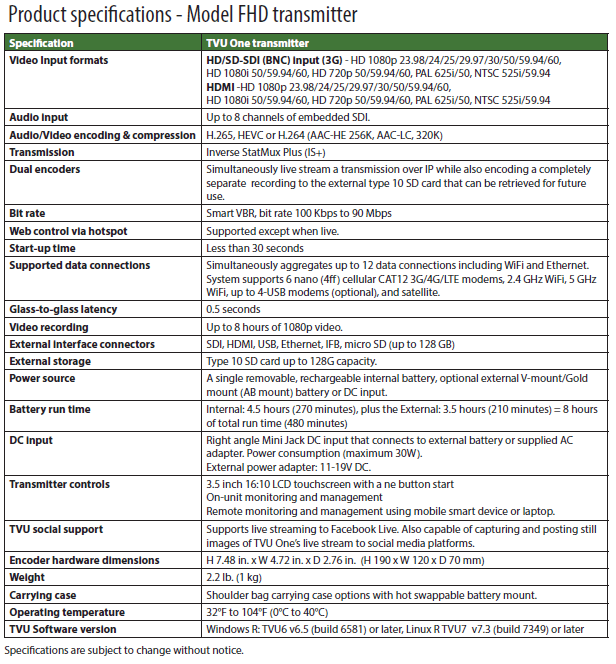
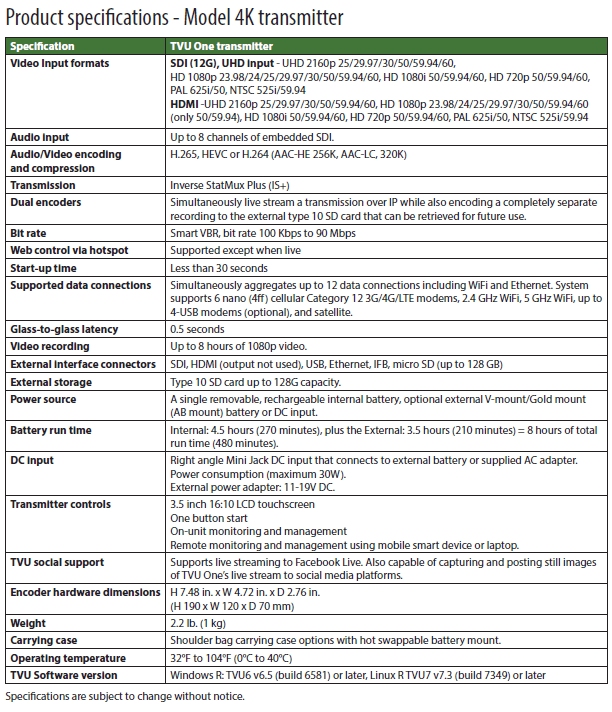
© Copyright 2024 TVU Networks Corporation. All rights reserved in all media.
Document Part Number: TVU One FHD and 4K SW UG Rev G EN 02-2024